Visitor Attraction Management: Strategies and Sustainability in the UK
VerifiedAdded on 2024/05/21
|26
|7182
|154
AI Summary
Contribute Materials
Your contribution can guide someone’s learning journey. Share your
documents today.
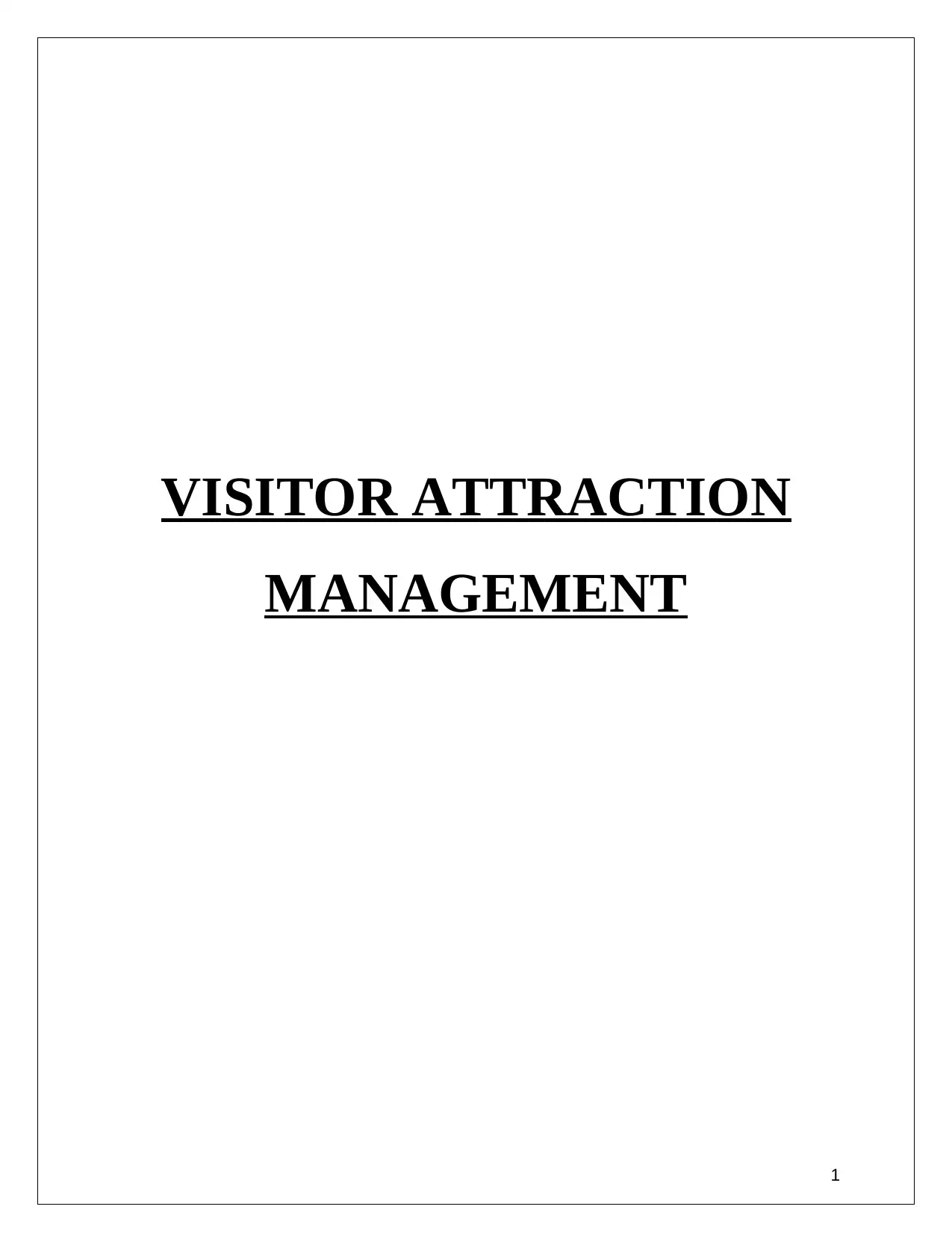
VISITOR ATTRACTION
MANAGEMENT
1
MANAGEMENT
1
Secure Best Marks with AI Grader
Need help grading? Try our AI Grader for instant feedback on your assignments.
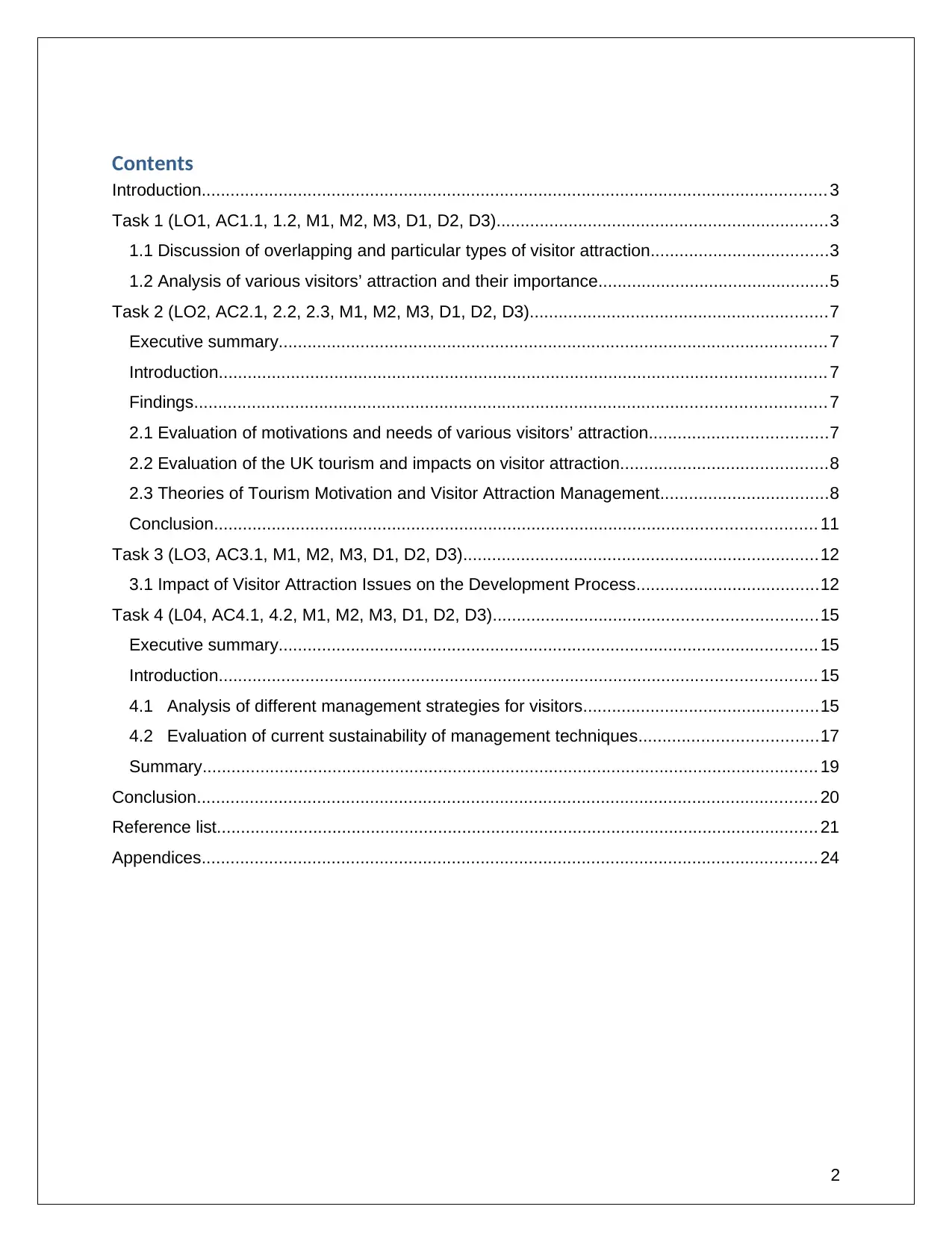
Contents
Introduction.................................................................................................................................. 3
Task 1 (LO1, AC1.1, 1.2, M1, M2, M3, D1, D2, D3).....................................................................3
1.1 Discussion of overlapping and particular types of visitor attraction.....................................3
1.2 Analysis of various visitors’ attraction and their importance................................................5
Task 2 (LO2, AC2.1, 2.2, 2.3, M1, M2, M3, D1, D2, D3)..............................................................7
Executive summary.................................................................................................................. 7
Introduction.............................................................................................................................. 7
Findings................................................................................................................................... 7
2.1 Evaluation of motivations and needs of various visitors’ attraction.....................................7
2.2 Evaluation of the UK tourism and impacts on visitor attraction...........................................8
2.3 Theories of Tourism Motivation and Visitor Attraction Management...................................8
Conclusion............................................................................................................................. 11
Task 3 (LO3, AC3.1, M1, M2, M3, D1, D2, D3)..........................................................................12
3.1 Impact of Visitor Attraction Issues on the Development Process......................................12
Task 4 (L04, AC4.1, 4.2, M1, M2, M3, D1, D2, D3)...................................................................15
Executive summary................................................................................................................ 15
Introduction............................................................................................................................ 15
4.1 Analysis of different management strategies for visitors.................................................15
4.2 Evaluation of current sustainability of management techniques.....................................17
Summary................................................................................................................................ 19
Conclusion................................................................................................................................. 20
Reference list............................................................................................................................. 21
Appendices................................................................................................................................ 24
2
Introduction.................................................................................................................................. 3
Task 1 (LO1, AC1.1, 1.2, M1, M2, M3, D1, D2, D3).....................................................................3
1.1 Discussion of overlapping and particular types of visitor attraction.....................................3
1.2 Analysis of various visitors’ attraction and their importance................................................5
Task 2 (LO2, AC2.1, 2.2, 2.3, M1, M2, M3, D1, D2, D3)..............................................................7
Executive summary.................................................................................................................. 7
Introduction.............................................................................................................................. 7
Findings................................................................................................................................... 7
2.1 Evaluation of motivations and needs of various visitors’ attraction.....................................7
2.2 Evaluation of the UK tourism and impacts on visitor attraction...........................................8
2.3 Theories of Tourism Motivation and Visitor Attraction Management...................................8
Conclusion............................................................................................................................. 11
Task 3 (LO3, AC3.1, M1, M2, M3, D1, D2, D3)..........................................................................12
3.1 Impact of Visitor Attraction Issues on the Development Process......................................12
Task 4 (L04, AC4.1, 4.2, M1, M2, M3, D1, D2, D3)...................................................................15
Executive summary................................................................................................................ 15
Introduction............................................................................................................................ 15
4.1 Analysis of different management strategies for visitors.................................................15
4.2 Evaluation of current sustainability of management techniques.....................................17
Summary................................................................................................................................ 19
Conclusion................................................................................................................................. 20
Reference list............................................................................................................................. 21
Appendices................................................................................................................................ 24
2
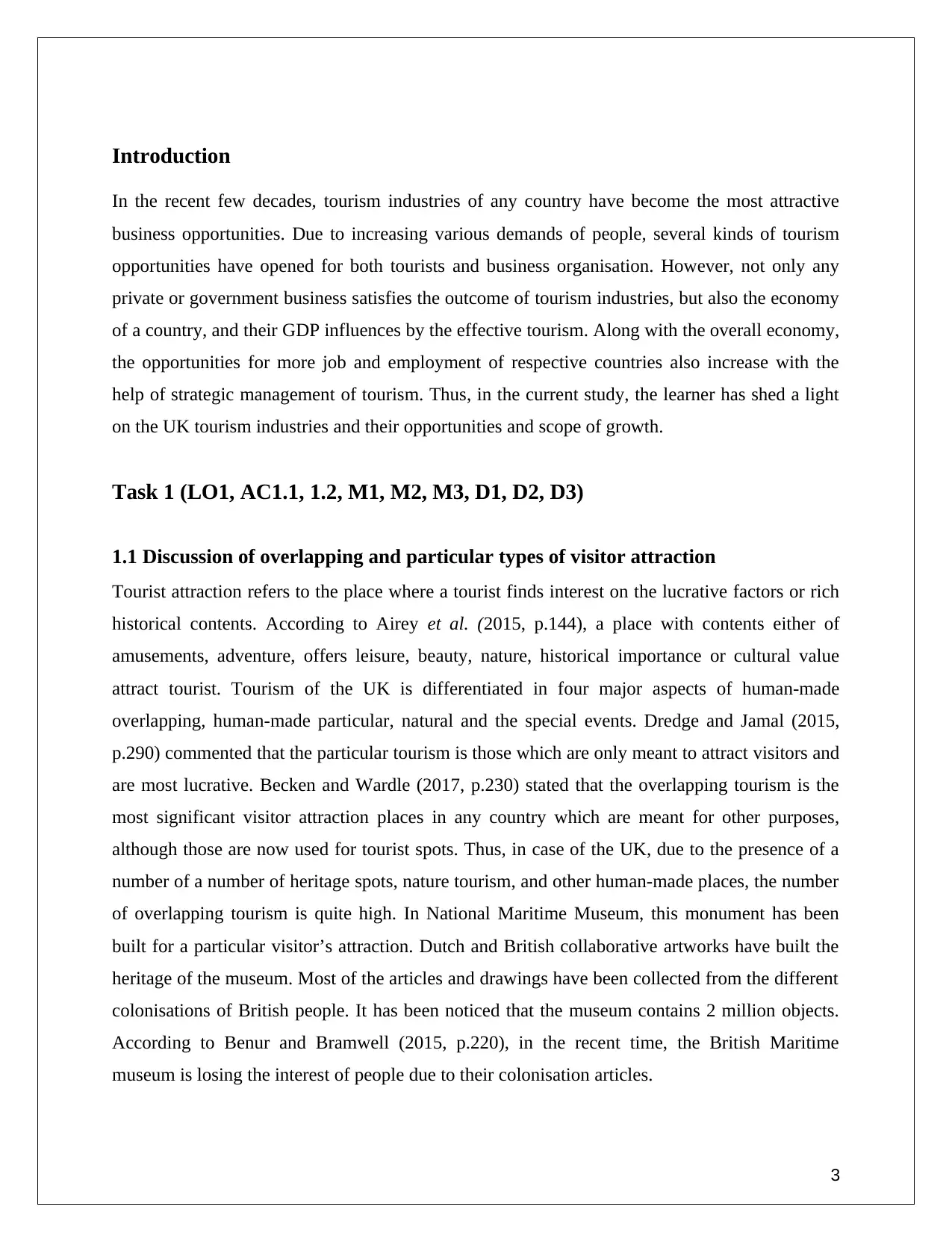
Introduction
In the recent few decades, tourism industries of any country have become the most attractive
business opportunities. Due to increasing various demands of people, several kinds of tourism
opportunities have opened for both tourists and business organisation. However, not only any
private or government business satisfies the outcome of tourism industries, but also the economy
of a country, and their GDP influences by the effective tourism. Along with the overall economy,
the opportunities for more job and employment of respective countries also increase with the
help of strategic management of tourism. Thus, in the current study, the learner has shed a light
on the UK tourism industries and their opportunities and scope of growth.
Task 1 (LO1, AC1.1, 1.2, M1, M2, M3, D1, D2, D3)
1.1 Discussion of overlapping and particular types of visitor attraction
Tourist attraction refers to the place where a tourist finds interest on the lucrative factors or rich
historical contents. According to Airey et al. (2015, p.144), a place with contents either of
amusements, adventure, offers leisure, beauty, nature, historical importance or cultural value
attract tourist. Tourism of the UK is differentiated in four major aspects of human-made
overlapping, human-made particular, natural and the special events. Dredge and Jamal (2015,
p.290) commented that the particular tourism is those which are only meant to attract visitors and
are most lucrative. Becken and Wardle (2017, p.230) stated that the overlapping tourism is the
most significant visitor attraction places in any country which are meant for other purposes,
although those are now used for tourist spots. Thus, in case of the UK, due to the presence of a
number of a number of heritage spots, nature tourism, and other human-made places, the number
of overlapping tourism is quite high. In National Maritime Museum, this monument has been
built for a particular visitor’s attraction. Dutch and British collaborative artworks have built the
heritage of the museum. Most of the articles and drawings have been collected from the different
colonisations of British people. It has been noticed that the museum contains 2 million objects.
According to Benur and Bramwell (2015, p.220), in the recent time, the British Maritime
museum is losing the interest of people due to their colonisation articles.
3
In the recent few decades, tourism industries of any country have become the most attractive
business opportunities. Due to increasing various demands of people, several kinds of tourism
opportunities have opened for both tourists and business organisation. However, not only any
private or government business satisfies the outcome of tourism industries, but also the economy
of a country, and their GDP influences by the effective tourism. Along with the overall economy,
the opportunities for more job and employment of respective countries also increase with the
help of strategic management of tourism. Thus, in the current study, the learner has shed a light
on the UK tourism industries and their opportunities and scope of growth.
Task 1 (LO1, AC1.1, 1.2, M1, M2, M3, D1, D2, D3)
1.1 Discussion of overlapping and particular types of visitor attraction
Tourist attraction refers to the place where a tourist finds interest on the lucrative factors or rich
historical contents. According to Airey et al. (2015, p.144), a place with contents either of
amusements, adventure, offers leisure, beauty, nature, historical importance or cultural value
attract tourist. Tourism of the UK is differentiated in four major aspects of human-made
overlapping, human-made particular, natural and the special events. Dredge and Jamal (2015,
p.290) commented that the particular tourism is those which are only meant to attract visitors and
are most lucrative. Becken and Wardle (2017, p.230) stated that the overlapping tourism is the
most significant visitor attraction places in any country which are meant for other purposes,
although those are now used for tourist spots. Thus, in case of the UK, due to the presence of a
number of a number of heritage spots, nature tourism, and other human-made places, the number
of overlapping tourism is quite high. In National Maritime Museum, this monument has been
built for a particular visitor’s attraction. Dutch and British collaborative artworks have built the
heritage of the museum. Most of the articles and drawings have been collected from the different
colonisations of British people. It has been noticed that the museum contains 2 million objects.
According to Benur and Bramwell (2015, p.220), in the recent time, the British Maritime
museum is losing the interest of people due to their colonisation articles.
3

Figure 1: Types of visitor attraction
(Source: McKercher and Tung, 2015, pp.313)
On the other hand, in case of the Greenwich Park, visitors are attracted by the Anglo Saxon
Turmali, Picturesque walks, rose garden and lovely green scenery. Along with this, a Camera
observatory is also present in this place by which people can watch the surrounding city.
However, this place has been built for the Royal Observatory purpose which has now become the
attraction of visitors. Thus, this place is one of the leading overlapping visitor attraction places
where almost 30 thousand people visit every day. However, the most significant overlapping
visitor attraction place is The Queen's Palace. At the beginning of the royal rule, the Queen used
to live here and now this is the official residence of the Queen. The entire building is built in the
British Roman architectural style. More than 50,000 people visit every day (alva.org, 2017). As
opined by Connell et al. (2015, p.288), with the help of these places the GDP of the country has
increased. Since 2011, the UK is planning on incorporating strategic plans to evolve their
heritage spots because of overlapping tourism attraction. According to Cang et al. (2014, p.607),
with the help of strategic management in the tourism and the hospitality services, a country can
increase their production and economic growth. Hanefeld et al. (2014, p.413) supported and
commented that, with the help of proper tourism management, the UK has increased their scope
4
Touris
m
Natural
Human
made
particular
Events
Human
made
overlapping
(Source: McKercher and Tung, 2015, pp.313)
On the other hand, in case of the Greenwich Park, visitors are attracted by the Anglo Saxon
Turmali, Picturesque walks, rose garden and lovely green scenery. Along with this, a Camera
observatory is also present in this place by which people can watch the surrounding city.
However, this place has been built for the Royal Observatory purpose which has now become the
attraction of visitors. Thus, this place is one of the leading overlapping visitor attraction places
where almost 30 thousand people visit every day. However, the most significant overlapping
visitor attraction place is The Queen's Palace. At the beginning of the royal rule, the Queen used
to live here and now this is the official residence of the Queen. The entire building is built in the
British Roman architectural style. More than 50,000 people visit every day (alva.org, 2017). As
opined by Connell et al. (2015, p.288), with the help of these places the GDP of the country has
increased. Since 2011, the UK is planning on incorporating strategic plans to evolve their
heritage spots because of overlapping tourism attraction. According to Cang et al. (2014, p.607),
with the help of strategic management in the tourism and the hospitality services, a country can
increase their production and economic growth. Hanefeld et al. (2014, p.413) supported and
commented that, with the help of proper tourism management, the UK has increased their scope
4
Touris
m
Natural
Human
made
particular
Events
Human
made
overlapping
Secure Best Marks with AI Grader
Need help grading? Try our AI Grader for instant feedback on your assignments.
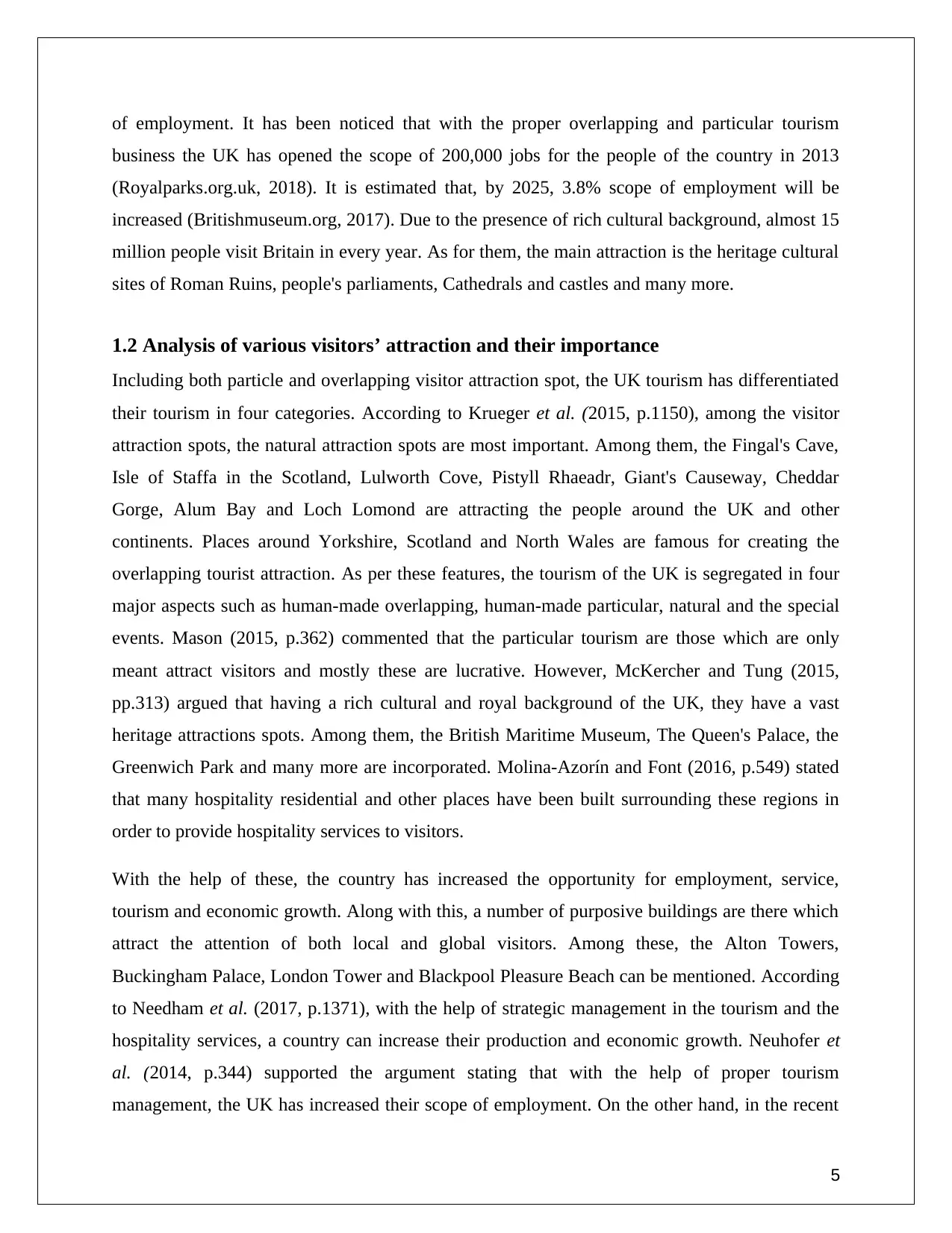
of employment. It has been noticed that with the proper overlapping and particular tourism
business the UK has opened the scope of 200,000 jobs for the people of the country in 2013
(Royalparks.org.uk, 2018). It is estimated that, by 2025, 3.8% scope of employment will be
increased (Britishmuseum.org, 2017). Due to the presence of rich cultural background, almost 15
million people visit Britain in every year. As for them, the main attraction is the heritage cultural
sites of Roman Ruins, people's parliaments, Cathedrals and castles and many more.
1.2 Analysis of various visitors’ attraction and their importance
Including both particle and overlapping visitor attraction spot, the UK tourism has differentiated
their tourism in four categories. According to Krueger et al. (2015, p.1150), among the visitor
attraction spots, the natural attraction spots are most important. Among them, the Fingal's Cave,
Isle of Staffa in the Scotland, Lulworth Cove, Pistyll Rhaeadr, Giant's Causeway, Cheddar
Gorge, Alum Bay and Loch Lomond are attracting the people around the UK and other
continents. Places around Yorkshire, Scotland and North Wales are famous for creating the
overlapping tourist attraction. As per these features, the tourism of the UK is segregated in four
major aspects such as human-made overlapping, human-made particular, natural and the special
events. Mason (2015, p.362) commented that the particular tourism are those which are only
meant attract visitors and mostly these are lucrative. However, McKercher and Tung (2015,
pp.313) argued that having a rich cultural and royal background of the UK, they have a vast
heritage attractions spots. Among them, the British Maritime Museum, The Queen's Palace, the
Greenwich Park and many more are incorporated. Molina-Azorín and Font (2016, p.549) stated
that many hospitality residential and other places have been built surrounding these regions in
order to provide hospitality services to visitors.
With the help of these, the country has increased the opportunity for employment, service,
tourism and economic growth. Along with this, a number of purposive buildings are there which
attract the attention of both local and global visitors. Among these, the Alton Towers,
Buckingham Palace, London Tower and Blackpool Pleasure Beach can be mentioned. According
to Needham et al. (2017, p.1371), with the help of strategic management in the tourism and the
hospitality services, a country can increase their production and economic growth. Neuhofer et
al. (2014, p.344) supported the argument stating that with the help of proper tourism
management, the UK has increased their scope of employment. On the other hand, in the recent
5
business the UK has opened the scope of 200,000 jobs for the people of the country in 2013
(Royalparks.org.uk, 2018). It is estimated that, by 2025, 3.8% scope of employment will be
increased (Britishmuseum.org, 2017). Due to the presence of rich cultural background, almost 15
million people visit Britain in every year. As for them, the main attraction is the heritage cultural
sites of Roman Ruins, people's parliaments, Cathedrals and castles and many more.
1.2 Analysis of various visitors’ attraction and their importance
Including both particle and overlapping visitor attraction spot, the UK tourism has differentiated
their tourism in four categories. According to Krueger et al. (2015, p.1150), among the visitor
attraction spots, the natural attraction spots are most important. Among them, the Fingal's Cave,
Isle of Staffa in the Scotland, Lulworth Cove, Pistyll Rhaeadr, Giant's Causeway, Cheddar
Gorge, Alum Bay and Loch Lomond are attracting the people around the UK and other
continents. Places around Yorkshire, Scotland and North Wales are famous for creating the
overlapping tourist attraction. As per these features, the tourism of the UK is segregated in four
major aspects such as human-made overlapping, human-made particular, natural and the special
events. Mason (2015, p.362) commented that the particular tourism are those which are only
meant attract visitors and mostly these are lucrative. However, McKercher and Tung (2015,
pp.313) argued that having a rich cultural and royal background of the UK, they have a vast
heritage attractions spots. Among them, the British Maritime Museum, The Queen's Palace, the
Greenwich Park and many more are incorporated. Molina-Azorín and Font (2016, p.549) stated
that many hospitality residential and other places have been built surrounding these regions in
order to provide hospitality services to visitors.
With the help of these, the country has increased the opportunity for employment, service,
tourism and economic growth. Along with this, a number of purposive buildings are there which
attract the attention of both local and global visitors. Among these, the Alton Towers,
Buckingham Palace, London Tower and Blackpool Pleasure Beach can be mentioned. According
to Needham et al. (2017, p.1371), with the help of strategic management in the tourism and the
hospitality services, a country can increase their production and economic growth. Neuhofer et
al. (2014, p.344) supported the argument stating that with the help of proper tourism
management, the UK has increased their scope of employment. On the other hand, in the recent
5
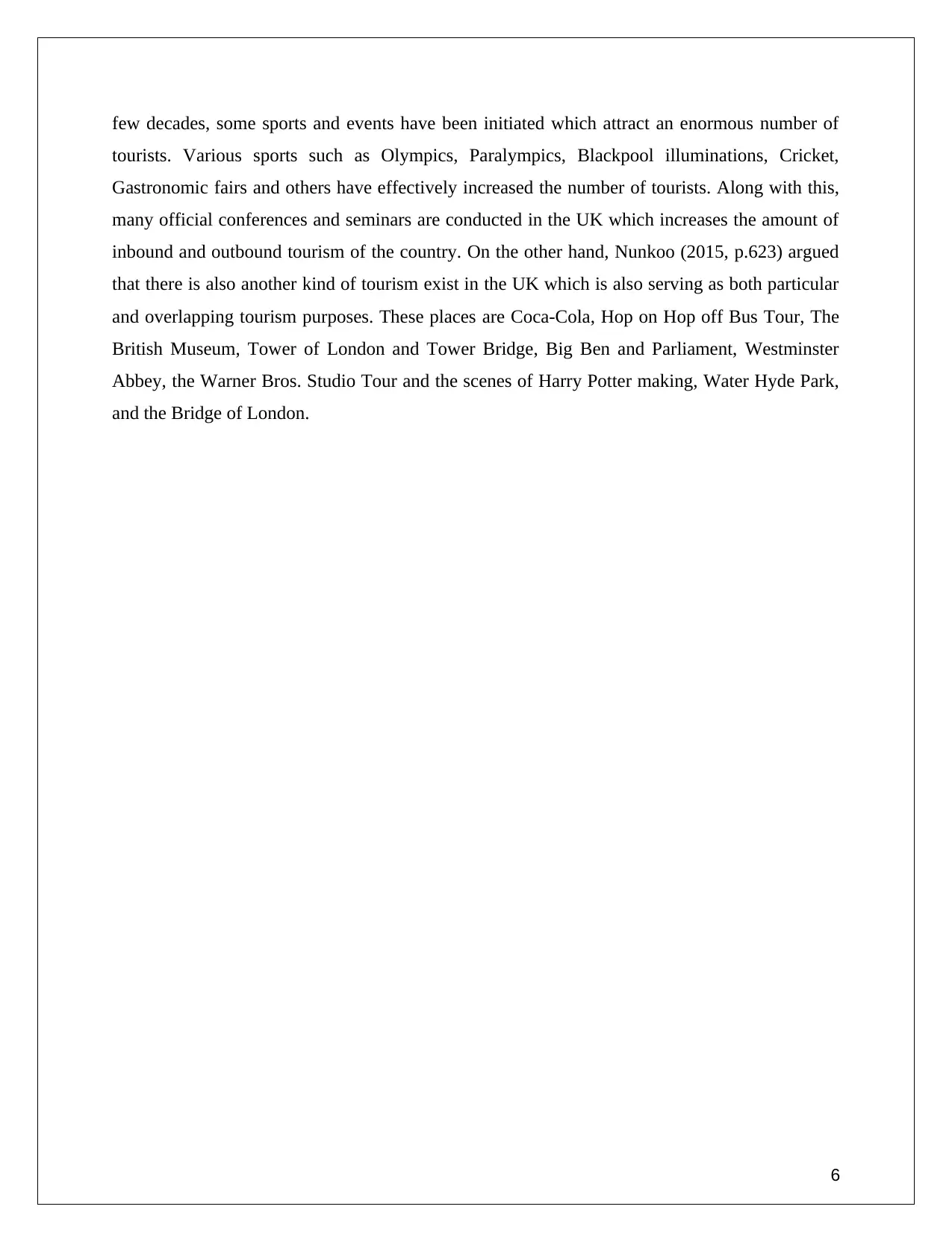
few decades, some sports and events have been initiated which attract an enormous number of
tourists. Various sports such as Olympics, Paralympics, Blackpool illuminations, Cricket,
Gastronomic fairs and others have effectively increased the number of tourists. Along with this,
many official conferences and seminars are conducted in the UK which increases the amount of
inbound and outbound tourism of the country. On the other hand, Nunkoo (2015, p.623) argued
that there is also another kind of tourism exist in the UK which is also serving as both particular
and overlapping tourism purposes. These places are Coca-Cola, Hop on Hop off Bus Tour, The
British Museum, Tower of London and Tower Bridge, Big Ben and Parliament, Westminster
Abbey, the Warner Bros. Studio Tour and the scenes of Harry Potter making, Water Hyde Park,
and the Bridge of London.
6
tourists. Various sports such as Olympics, Paralympics, Blackpool illuminations, Cricket,
Gastronomic fairs and others have effectively increased the number of tourists. Along with this,
many official conferences and seminars are conducted in the UK which increases the amount of
inbound and outbound tourism of the country. On the other hand, Nunkoo (2015, p.623) argued
that there is also another kind of tourism exist in the UK which is also serving as both particular
and overlapping tourism purposes. These places are Coca-Cola, Hop on Hop off Bus Tour, The
British Museum, Tower of London and Tower Bridge, Big Ben and Parliament, Westminster
Abbey, the Warner Bros. Studio Tour and the scenes of Harry Potter making, Water Hyde Park,
and the Bridge of London.
6
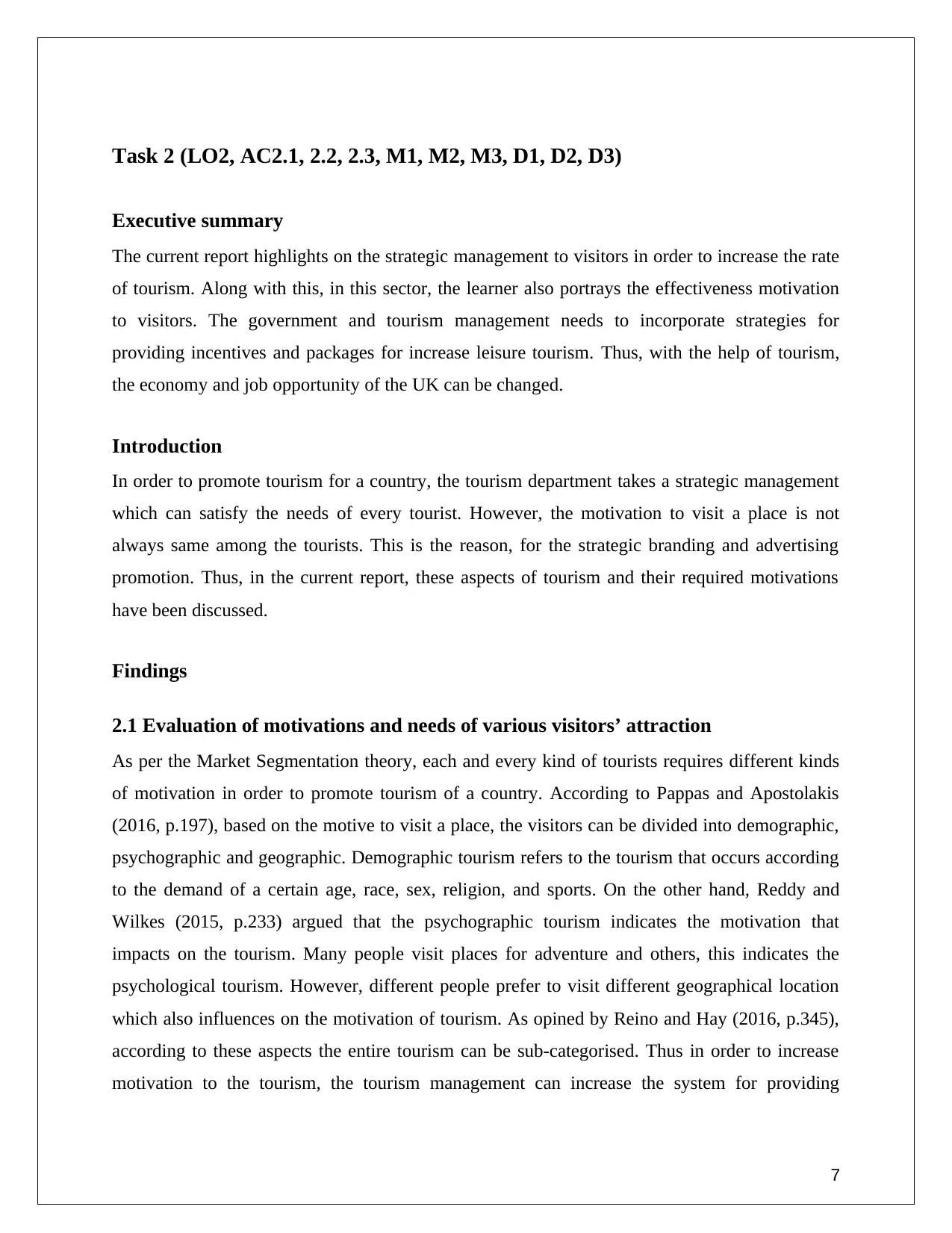
Task 2 (LO2, AC2.1, 2.2, 2.3, M1, M2, M3, D1, D2, D3)
Executive summary
The current report highlights on the strategic management to visitors in order to increase the rate
of tourism. Along with this, in this sector, the learner also portrays the effectiveness motivation
to visitors. The government and tourism management needs to incorporate strategies for
providing incentives and packages for increase leisure tourism. Thus, with the help of tourism,
the economy and job opportunity of the UK can be changed.
Introduction
In order to promote tourism for a country, the tourism department takes a strategic management
which can satisfy the needs of every tourist. However, the motivation to visit a place is not
always same among the tourists. This is the reason, for the strategic branding and advertising
promotion. Thus, in the current report, these aspects of tourism and their required motivations
have been discussed.
Findings
2.1 Evaluation of motivations and needs of various visitors’ attraction
As per the Market Segmentation theory, each and every kind of tourists requires different kinds
of motivation in order to promote tourism of a country. According to Pappas and Apostolakis
(2016, p.197), based on the motive to visit a place, the visitors can be divided into demographic,
psychographic and geographic. Demographic tourism refers to the tourism that occurs according
to the demand of a certain age, race, sex, religion, and sports. On the other hand, Reddy and
Wilkes (2015, p.233) argued that the psychographic tourism indicates the motivation that
impacts on the tourism. Many people visit places for adventure and others, this indicates the
psychological tourism. However, different people prefer to visit different geographical location
which also influences on the motivation of tourism. As opined by Reino and Hay (2016, p.345),
according to these aspects the entire tourism can be sub-categorised. Thus in order to increase
motivation to the tourism, the tourism management can increase the system for providing
7
Executive summary
The current report highlights on the strategic management to visitors in order to increase the rate
of tourism. Along with this, in this sector, the learner also portrays the effectiveness motivation
to visitors. The government and tourism management needs to incorporate strategies for
providing incentives and packages for increase leisure tourism. Thus, with the help of tourism,
the economy and job opportunity of the UK can be changed.
Introduction
In order to promote tourism for a country, the tourism department takes a strategic management
which can satisfy the needs of every tourist. However, the motivation to visit a place is not
always same among the tourists. This is the reason, for the strategic branding and advertising
promotion. Thus, in the current report, these aspects of tourism and their required motivations
have been discussed.
Findings
2.1 Evaluation of motivations and needs of various visitors’ attraction
As per the Market Segmentation theory, each and every kind of tourists requires different kinds
of motivation in order to promote tourism of a country. According to Pappas and Apostolakis
(2016, p.197), based on the motive to visit a place, the visitors can be divided into demographic,
psychographic and geographic. Demographic tourism refers to the tourism that occurs according
to the demand of a certain age, race, sex, religion, and sports. On the other hand, Reddy and
Wilkes (2015, p.233) argued that the psychographic tourism indicates the motivation that
impacts on the tourism. Many people visit places for adventure and others, this indicates the
psychological tourism. However, different people prefer to visit different geographical location
which also influences on the motivation of tourism. As opined by Reino and Hay (2016, p.345),
according to these aspects the entire tourism can be sub-categorised. Thus in order to increase
motivation to the tourism, the tourism management can increase the system for providing
7
Paraphrase This Document
Need a fresh take? Get an instant paraphrase of this document with our AI Paraphraser
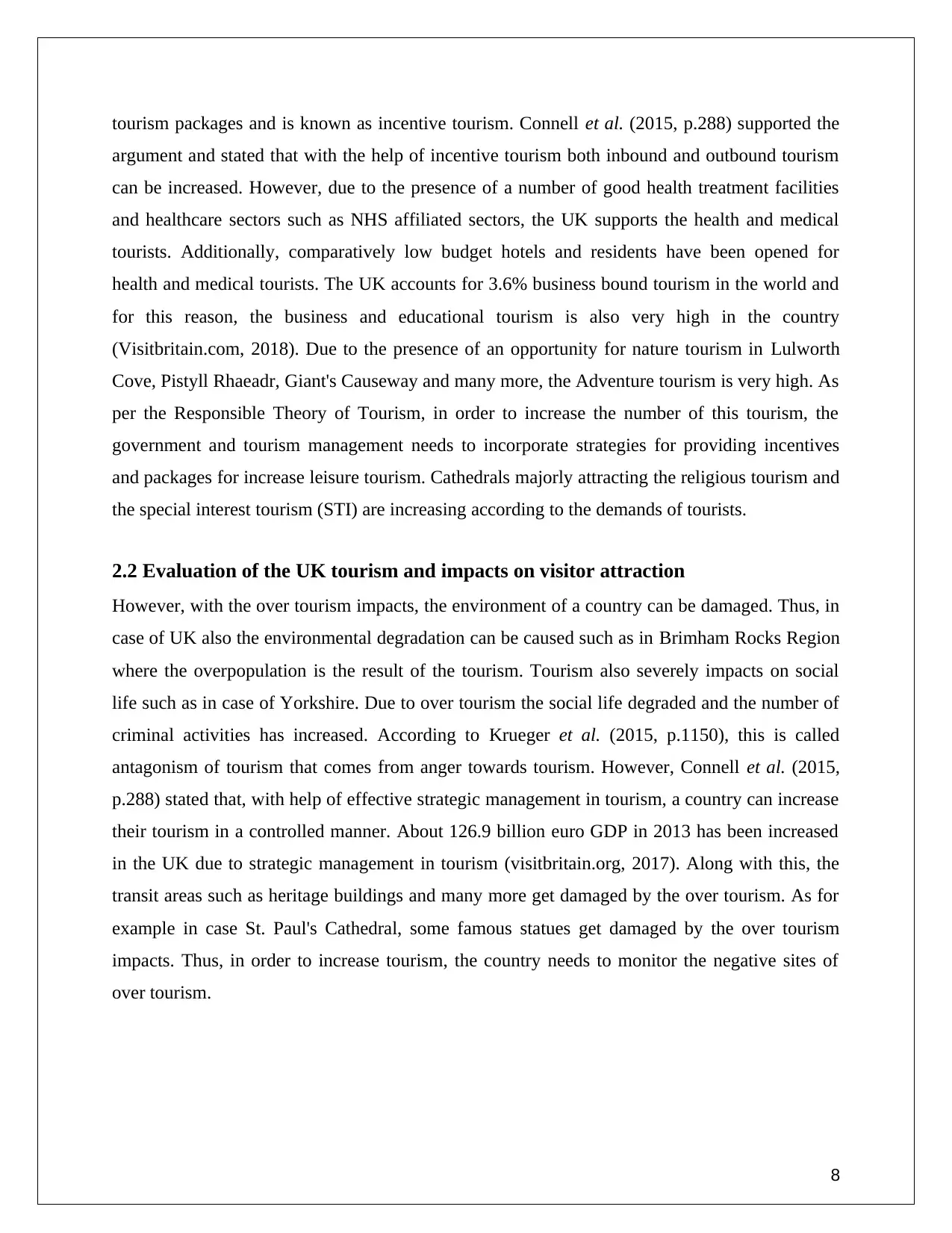
tourism packages and is known as incentive tourism. Connell et al. (2015, p.288) supported the
argument and stated that with the help of incentive tourism both inbound and outbound tourism
can be increased. However, due to the presence of a number of good health treatment facilities
and healthcare sectors such as NHS affiliated sectors, the UK supports the health and medical
tourists. Additionally, comparatively low budget hotels and residents have been opened for
health and medical tourists. The UK accounts for 3.6% business bound tourism in the world and
for this reason, the business and educational tourism is also very high in the country
(Visitbritain.com, 2018). Due to the presence of an opportunity for nature tourism in Lulworth
Cove, Pistyll Rhaeadr, Giant's Causeway and many more, the Adventure tourism is very high. As
per the Responsible Theory of Tourism, in order to increase the number of this tourism, the
government and tourism management needs to incorporate strategies for providing incentives
and packages for increase leisure tourism. Cathedrals majorly attracting the religious tourism and
the special interest tourism (STI) are increasing according to the demands of tourists.
2.2 Evaluation of the UK tourism and impacts on visitor attraction
However, with the over tourism impacts, the environment of a country can be damaged. Thus, in
case of UK also the environmental degradation can be caused such as in Brimham Rocks Region
where the overpopulation is the result of the tourism. Tourism also severely impacts on social
life such as in case of Yorkshire. Due to over tourism the social life degraded and the number of
criminal activities has increased. According to Krueger et al. (2015, p.1150), this is called
antagonism of tourism that comes from anger towards tourism. However, Connell et al. (2015,
p.288) stated that, with help of effective strategic management in tourism, a country can increase
their tourism in a controlled manner. About 126.9 billion euro GDP in 2013 has been increased
in the UK due to strategic management in tourism (visitbritain.org, 2017). Along with this, the
transit areas such as heritage buildings and many more get damaged by the over tourism. As for
example in case St. Paul's Cathedral, some famous statues get damaged by the over tourism
impacts. Thus, in order to increase tourism, the country needs to monitor the negative sites of
over tourism.
8
argument and stated that with the help of incentive tourism both inbound and outbound tourism
can be increased. However, due to the presence of a number of good health treatment facilities
and healthcare sectors such as NHS affiliated sectors, the UK supports the health and medical
tourists. Additionally, comparatively low budget hotels and residents have been opened for
health and medical tourists. The UK accounts for 3.6% business bound tourism in the world and
for this reason, the business and educational tourism is also very high in the country
(Visitbritain.com, 2018). Due to the presence of an opportunity for nature tourism in Lulworth
Cove, Pistyll Rhaeadr, Giant's Causeway and many more, the Adventure tourism is very high. As
per the Responsible Theory of Tourism, in order to increase the number of this tourism, the
government and tourism management needs to incorporate strategies for providing incentives
and packages for increase leisure tourism. Cathedrals majorly attracting the religious tourism and
the special interest tourism (STI) are increasing according to the demands of tourists.
2.2 Evaluation of the UK tourism and impacts on visitor attraction
However, with the over tourism impacts, the environment of a country can be damaged. Thus, in
case of UK also the environmental degradation can be caused such as in Brimham Rocks Region
where the overpopulation is the result of the tourism. Tourism also severely impacts on social
life such as in case of Yorkshire. Due to over tourism the social life degraded and the number of
criminal activities has increased. According to Krueger et al. (2015, p.1150), this is called
antagonism of tourism that comes from anger towards tourism. However, Connell et al. (2015,
p.288) stated that, with help of effective strategic management in tourism, a country can increase
their tourism in a controlled manner. About 126.9 billion euro GDP in 2013 has been increased
in the UK due to strategic management in tourism (visitbritain.org, 2017). Along with this, the
transit areas such as heritage buildings and many more get damaged by the over tourism. As for
example in case St. Paul's Cathedral, some famous statues get damaged by the over tourism
impacts. Thus, in order to increase tourism, the country needs to monitor the negative sites of
over tourism.
8
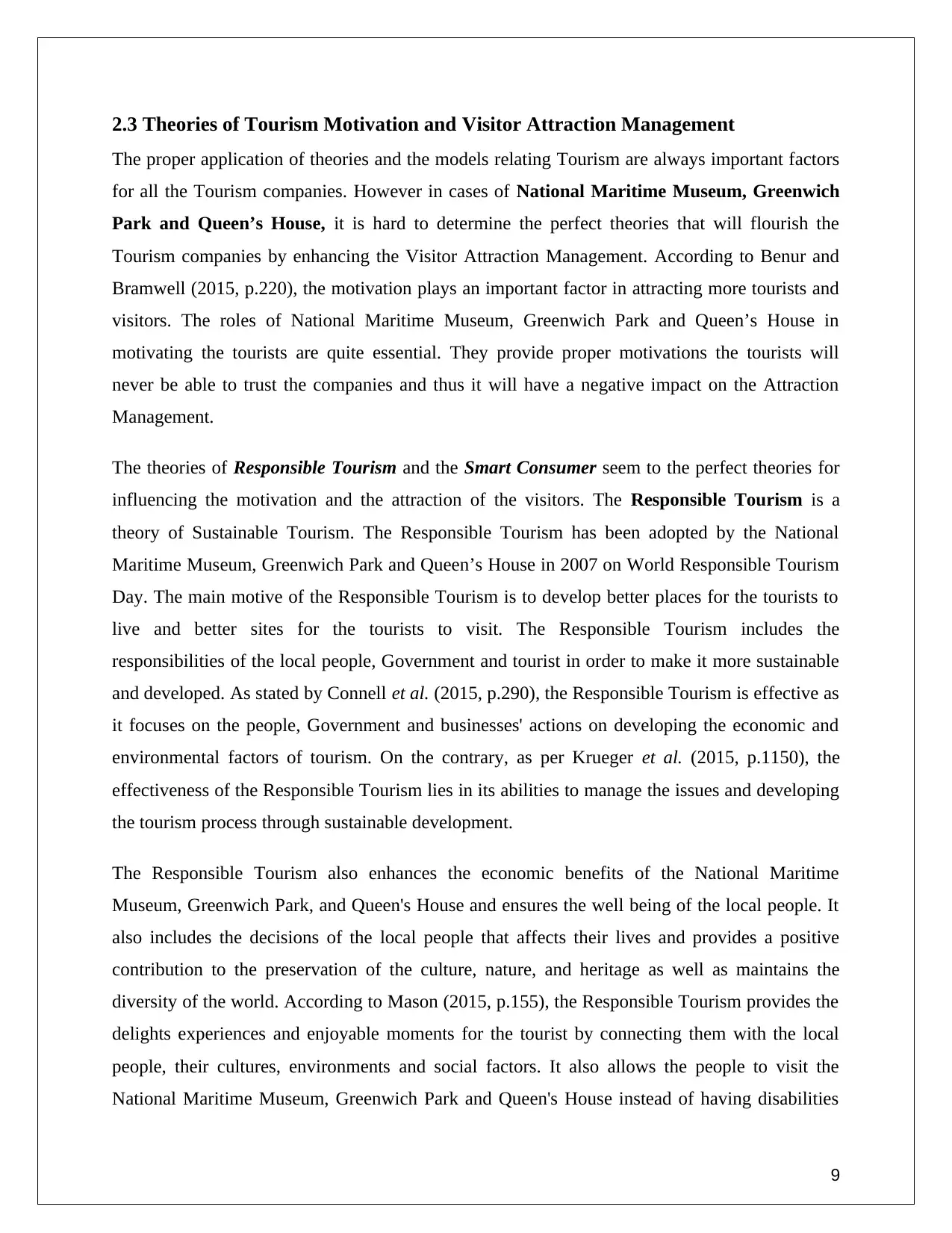
2.3 Theories of Tourism Motivation and Visitor Attraction Management
The proper application of theories and the models relating Tourism are always important factors
for all the Tourism companies. However in cases of National Maritime Museum, Greenwich
Park and Queen’s House, it is hard to determine the perfect theories that will flourish the
Tourism companies by enhancing the Visitor Attraction Management. According to Benur and
Bramwell (2015, p.220), the motivation plays an important factor in attracting more tourists and
visitors. The roles of National Maritime Museum, Greenwich Park and Queen’s House in
motivating the tourists are quite essential. They provide proper motivations the tourists will
never be able to trust the companies and thus it will have a negative impact on the Attraction
Management.
The theories of Responsible Tourism and the Smart Consumer seem to the perfect theories for
influencing the motivation and the attraction of the visitors. The Responsible Tourism is a
theory of Sustainable Tourism. The Responsible Tourism has been adopted by the National
Maritime Museum, Greenwich Park and Queen’s House in 2007 on World Responsible Tourism
Day. The main motive of the Responsible Tourism is to develop better places for the tourists to
live and better sites for the tourists to visit. The Responsible Tourism includes the
responsibilities of the local people, Government and tourist in order to make it more sustainable
and developed. As stated by Connell et al. (2015, p.290), the Responsible Tourism is effective as
it focuses on the people, Government and businesses' actions on developing the economic and
environmental factors of tourism. On the contrary, as per Krueger et al. (2015, p.1150), the
effectiveness of the Responsible Tourism lies in its abilities to manage the issues and developing
the tourism process through sustainable development.
The Responsible Tourism also enhances the economic benefits of the National Maritime
Museum, Greenwich Park, and Queen's House and ensures the well being of the local people. It
also includes the decisions of the local people that affects their lives and provides a positive
contribution to the preservation of the culture, nature, and heritage as well as maintains the
diversity of the world. According to Mason (2015, p.155), the Responsible Tourism provides the
delights experiences and enjoyable moments for the tourist by connecting them with the local
people, their cultures, environments and social factors. It also allows the people to visit the
National Maritime Museum, Greenwich Park and Queen's House instead of having disabilities
9
The proper application of theories and the models relating Tourism are always important factors
for all the Tourism companies. However in cases of National Maritime Museum, Greenwich
Park and Queen’s House, it is hard to determine the perfect theories that will flourish the
Tourism companies by enhancing the Visitor Attraction Management. According to Benur and
Bramwell (2015, p.220), the motivation plays an important factor in attracting more tourists and
visitors. The roles of National Maritime Museum, Greenwich Park and Queen’s House in
motivating the tourists are quite essential. They provide proper motivations the tourists will
never be able to trust the companies and thus it will have a negative impact on the Attraction
Management.
The theories of Responsible Tourism and the Smart Consumer seem to the perfect theories for
influencing the motivation and the attraction of the visitors. The Responsible Tourism is a
theory of Sustainable Tourism. The Responsible Tourism has been adopted by the National
Maritime Museum, Greenwich Park and Queen’s House in 2007 on World Responsible Tourism
Day. The main motive of the Responsible Tourism is to develop better places for the tourists to
live and better sites for the tourists to visit. The Responsible Tourism includes the
responsibilities of the local people, Government and tourist in order to make it more sustainable
and developed. As stated by Connell et al. (2015, p.290), the Responsible Tourism is effective as
it focuses on the people, Government and businesses' actions on developing the economic and
environmental factors of tourism. On the contrary, as per Krueger et al. (2015, p.1150), the
effectiveness of the Responsible Tourism lies in its abilities to manage the issues and developing
the tourism process through sustainable development.
The Responsible Tourism also enhances the economic benefits of the National Maritime
Museum, Greenwich Park, and Queen's House and ensures the well being of the local people. It
also includes the decisions of the local people that affects their lives and provides a positive
contribution to the preservation of the culture, nature, and heritage as well as maintains the
diversity of the world. According to Mason (2015, p.155), the Responsible Tourism provides the
delights experiences and enjoyable moments for the tourist by connecting them with the local
people, their cultures, environments and social factors. It also allows the people to visit the
National Maritime Museum, Greenwich Park and Queen's House instead of having disabilities
9

and disadvantages. The strong bonding has created a positive reputation, pride, and confidence of
the places among the tourists. The Smart Consumer is another theory of Tourism that has
gained major popularity in the recent time and has been adopted by National Maritime Museum,
Greenwich Park, and Queen's House. As per Reino and Hay (2016, p.185), the theory of Smart
Consumer is the process of highlighting the historical places and turning them into national
heritage.
The National Maritime Museum, Greenwich Park, and the Queen's House all of them possess a
bright history. Thus the adoption of the Smart Consumer Theory turns these places into national
heritage. On the contrary argued by Wang et al. (2016, p.317), the Smart Consumer is a group of
tourists that possess a large interest on the historical places of the world and their interest and
influences turn the historical places into national heritage. The frequent visit of the Smart
Consumers in the National Maritime Museum, Greenwich Park, and Queen's House has
improved both the financial structure and environment of these places. According to the Smart
Consumer theory, there are two kinds of visitors the first are the thoughtful visitors and the
second kinds are sophisticated new visitors. Thus, the Smart Consumers are responsible for
enhancing the historical places and making it popular among the tourist. Hence, the National
Maritime Museum, Greenwich Park, and Queen's House adopted the Smart Consumer theory
besides the Responsible Tourism in order to gain popularity in the modern world and represent
its historical past.
10
the places among the tourists. The Smart Consumer is another theory of Tourism that has
gained major popularity in the recent time and has been adopted by National Maritime Museum,
Greenwich Park, and Queen's House. As per Reino and Hay (2016, p.185), the theory of Smart
Consumer is the process of highlighting the historical places and turning them into national
heritage.
The National Maritime Museum, Greenwich Park, and the Queen's House all of them possess a
bright history. Thus the adoption of the Smart Consumer Theory turns these places into national
heritage. On the contrary argued by Wang et al. (2016, p.317), the Smart Consumer is a group of
tourists that possess a large interest on the historical places of the world and their interest and
influences turn the historical places into national heritage. The frequent visit of the Smart
Consumers in the National Maritime Museum, Greenwich Park, and Queen's House has
improved both the financial structure and environment of these places. According to the Smart
Consumer theory, there are two kinds of visitors the first are the thoughtful visitors and the
second kinds are sophisticated new visitors. Thus, the Smart Consumers are responsible for
enhancing the historical places and making it popular among the tourist. Hence, the National
Maritime Museum, Greenwich Park, and Queen's House adopted the Smart Consumer theory
besides the Responsible Tourism in order to gain popularity in the modern world and represent
its historical past.
10
Secure Best Marks with AI Grader
Need help grading? Try our AI Grader for instant feedback on your assignments.
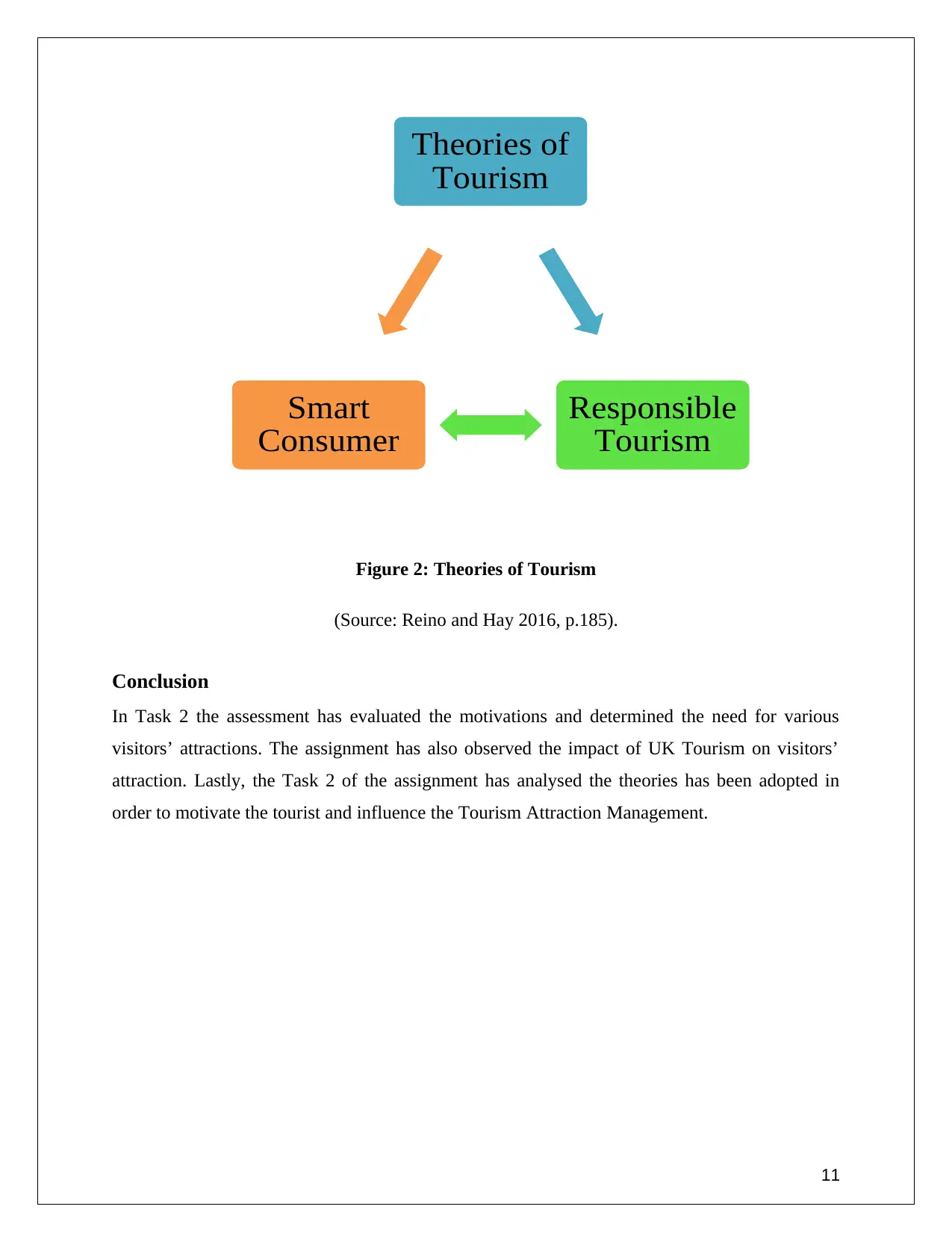
Figure 2: Theories of Tourism
(Source: Reino and Hay 2016, p.185).
Conclusion
In Task 2 the assessment has evaluated the motivations and determined the need for various
visitors’ attractions. The assignment has also observed the impact of UK Tourism on visitors’
attraction. Lastly, the Task 2 of the assignment has analysed the theories has been adopted in
order to motivate the tourist and influence the Tourism Attraction Management.
11
Theories of
Tourism
Responsible
Tourism
Smart
Consumer
(Source: Reino and Hay 2016, p.185).
Conclusion
In Task 2 the assessment has evaluated the motivations and determined the need for various
visitors’ attractions. The assignment has also observed the impact of UK Tourism on visitors’
attraction. Lastly, the Task 2 of the assignment has analysed the theories has been adopted in
order to motivate the tourist and influence the Tourism Attraction Management.
11
Theories of
Tourism
Responsible
Tourism
Smart
Consumer
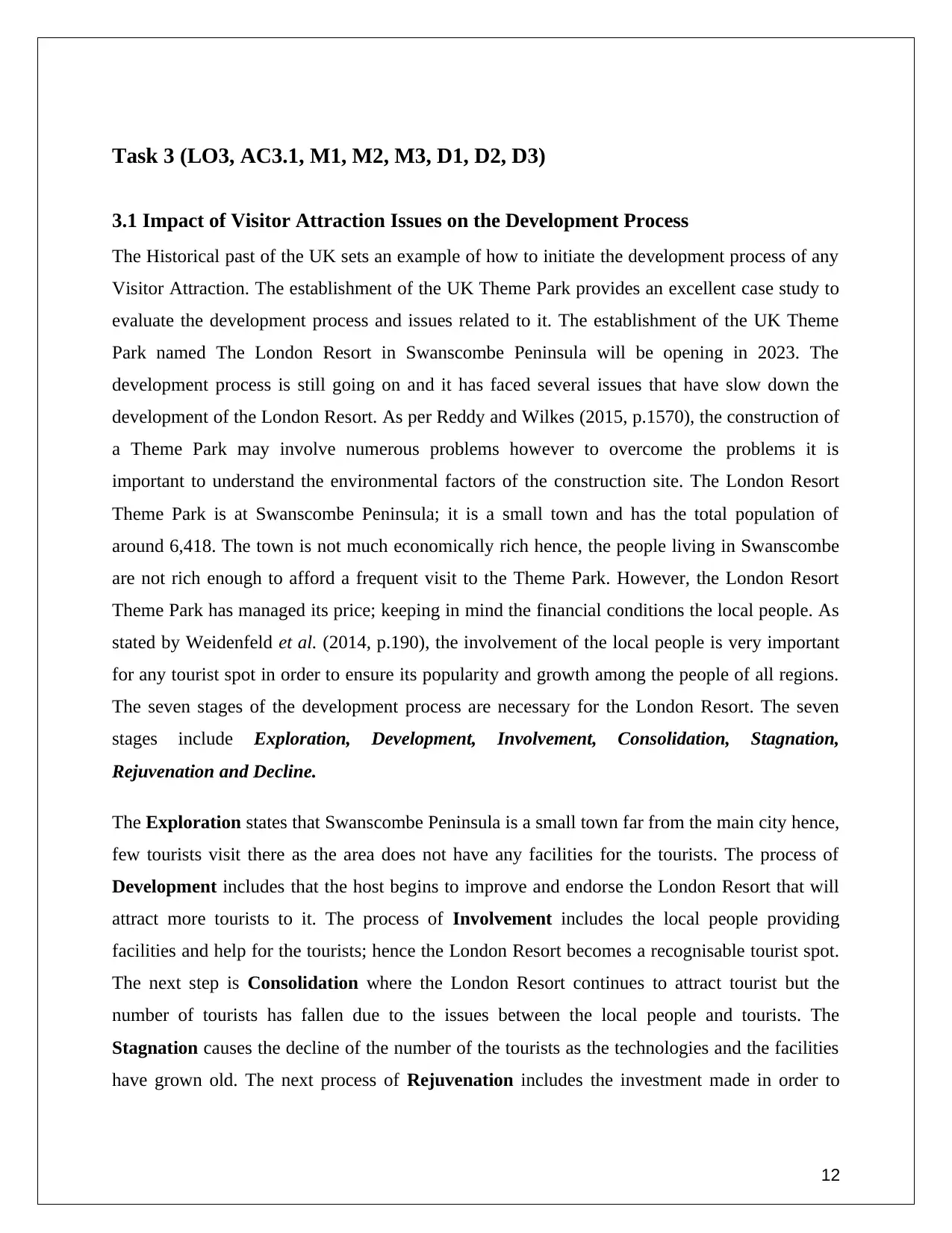
Task 3 (LO3, AC3.1, M1, M2, M3, D1, D2, D3)
3.1 Impact of Visitor Attraction Issues on the Development Process
The Historical past of the UK sets an example of how to initiate the development process of any
Visitor Attraction. The establishment of the UK Theme Park provides an excellent case study to
evaluate the development process and issues related to it. The establishment of the UK Theme
Park named The London Resort in Swanscombe Peninsula will be opening in 2023. The
development process is still going on and it has faced several issues that have slow down the
development of the London Resort. As per Reddy and Wilkes (2015, p.1570), the construction of
a Theme Park may involve numerous problems however to overcome the problems it is
important to understand the environmental factors of the construction site. The London Resort
Theme Park is at Swanscombe Peninsula; it is a small town and has the total population of
around 6,418. The town is not much economically rich hence, the people living in Swanscombe
are not rich enough to afford a frequent visit to the Theme Park. However, the London Resort
Theme Park has managed its price; keeping in mind the financial conditions the local people. As
stated by Weidenfeld et al. (2014, p.190), the involvement of the local people is very important
for any tourist spot in order to ensure its popularity and growth among the people of all regions.
The seven stages of the development process are necessary for the London Resort. The seven
stages include Exploration, Development, Involvement, Consolidation, Stagnation,
Rejuvenation and Decline.
The Exploration states that Swanscombe Peninsula is a small town far from the main city hence,
few tourists visit there as the area does not have any facilities for the tourists. The process of
Development includes that the host begins to improve and endorse the London Resort that will
attract more tourists to it. The process of Involvement includes the local people providing
facilities and help for the tourists; hence the London Resort becomes a recognisable tourist spot.
The next step is Consolidation where the London Resort continues to attract tourist but the
number of tourists has fallen due to the issues between the local people and tourists. The
Stagnation causes the decline of the number of the tourists as the technologies and the facilities
have grown old. The next process of Rejuvenation includes the investment made in order to
12
3.1 Impact of Visitor Attraction Issues on the Development Process
The Historical past of the UK sets an example of how to initiate the development process of any
Visitor Attraction. The establishment of the UK Theme Park provides an excellent case study to
evaluate the development process and issues related to it. The establishment of the UK Theme
Park named The London Resort in Swanscombe Peninsula will be opening in 2023. The
development process is still going on and it has faced several issues that have slow down the
development of the London Resort. As per Reddy and Wilkes (2015, p.1570), the construction of
a Theme Park may involve numerous problems however to overcome the problems it is
important to understand the environmental factors of the construction site. The London Resort
Theme Park is at Swanscombe Peninsula; it is a small town and has the total population of
around 6,418. The town is not much economically rich hence, the people living in Swanscombe
are not rich enough to afford a frequent visit to the Theme Park. However, the London Resort
Theme Park has managed its price; keeping in mind the financial conditions the local people. As
stated by Weidenfeld et al. (2014, p.190), the involvement of the local people is very important
for any tourist spot in order to ensure its popularity and growth among the people of all regions.
The seven stages of the development process are necessary for the London Resort. The seven
stages include Exploration, Development, Involvement, Consolidation, Stagnation,
Rejuvenation and Decline.
The Exploration states that Swanscombe Peninsula is a small town far from the main city hence,
few tourists visit there as the area does not have any facilities for the tourists. The process of
Development includes that the host begins to improve and endorse the London Resort that will
attract more tourists to it. The process of Involvement includes the local people providing
facilities and help for the tourists; hence the London Resort becomes a recognisable tourist spot.
The next step is Consolidation where the London Resort continues to attract tourist but the
number of tourists has fallen due to the issues between the local people and tourists. The
Stagnation causes the decline of the number of the tourists as the technologies and the facilities
have grown old. The next process of Rejuvenation includes the investment made in order to
12
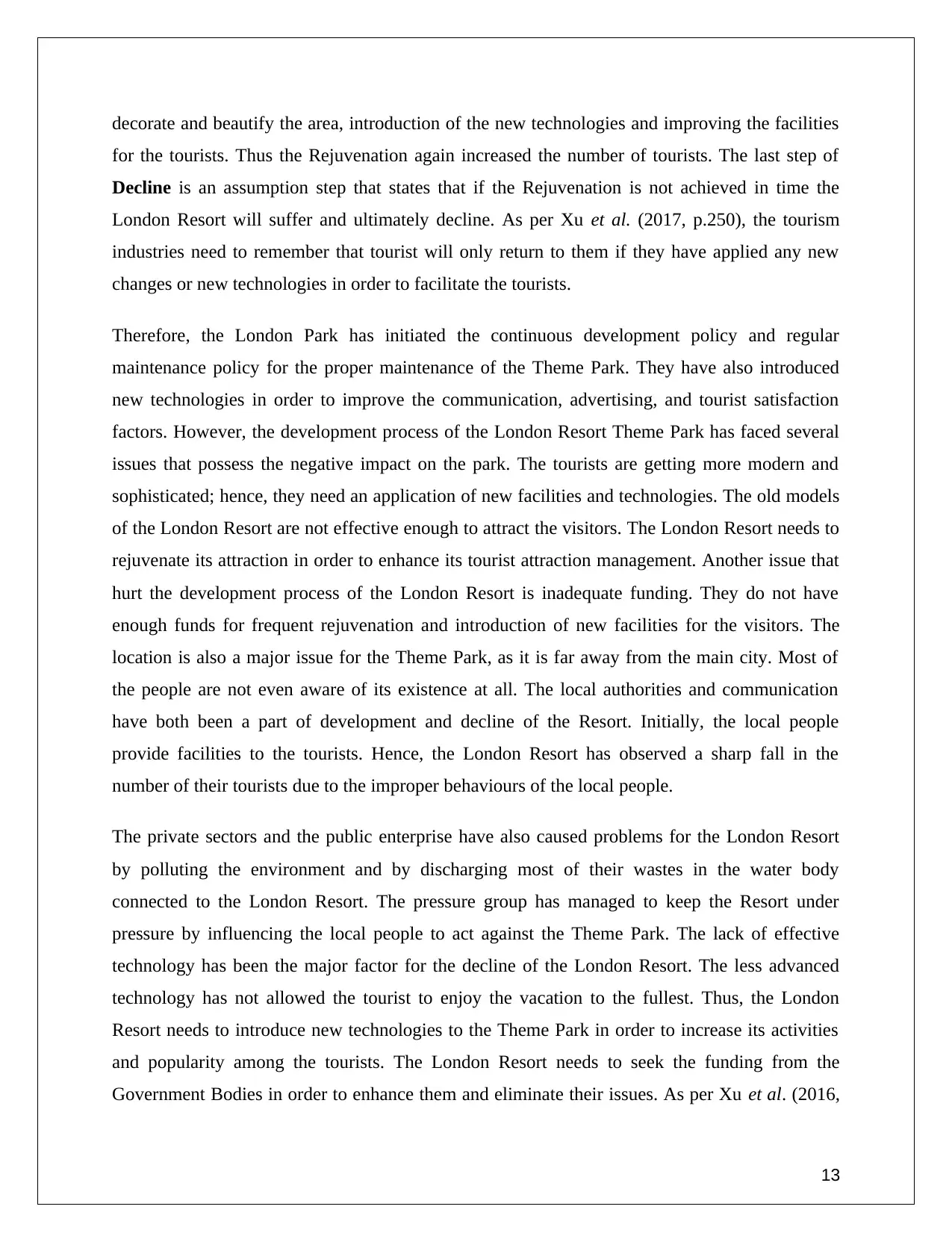
decorate and beautify the area, introduction of the new technologies and improving the facilities
for the tourists. Thus the Rejuvenation again increased the number of tourists. The last step of
Decline is an assumption step that states that if the Rejuvenation is not achieved in time the
London Resort will suffer and ultimately decline. As per Xu et al. (2017, p.250), the tourism
industries need to remember that tourist will only return to them if they have applied any new
changes or new technologies in order to facilitate the tourists.
Therefore, the London Park has initiated the continuous development policy and regular
maintenance policy for the proper maintenance of the Theme Park. They have also introduced
new technologies in order to improve the communication, advertising, and tourist satisfaction
factors. However, the development process of the London Resort Theme Park has faced several
issues that possess the negative impact on the park. The tourists are getting more modern and
sophisticated; hence, they need an application of new facilities and technologies. The old models
of the London Resort are not effective enough to attract the visitors. The London Resort needs to
rejuvenate its attraction in order to enhance its tourist attraction management. Another issue that
hurt the development process of the London Resort is inadequate funding. They do not have
enough funds for frequent rejuvenation and introduction of new facilities for the visitors. The
location is also a major issue for the Theme Park, as it is far away from the main city. Most of
the people are not even aware of its existence at all. The local authorities and communication
have both been a part of development and decline of the Resort. Initially, the local people
provide facilities to the tourists. Hence, the London Resort has observed a sharp fall in the
number of their tourists due to the improper behaviours of the local people.
The private sectors and the public enterprise have also caused problems for the London Resort
by polluting the environment and by discharging most of their wastes in the water body
connected to the London Resort. The pressure group has managed to keep the Resort under
pressure by influencing the local people to act against the Theme Park. The lack of effective
technology has been the major factor for the decline of the London Resort. The less advanced
technology has not allowed the tourist to enjoy the vacation to the fullest. Thus, the London
Resort needs to introduce new technologies to the Theme Park in order to increase its activities
and popularity among the tourists. The London Resort needs to seek the funding from the
Government Bodies in order to enhance them and eliminate their issues. As per Xu et al. (2016,
13
for the tourists. Thus the Rejuvenation again increased the number of tourists. The last step of
Decline is an assumption step that states that if the Rejuvenation is not achieved in time the
London Resort will suffer and ultimately decline. As per Xu et al. (2017, p.250), the tourism
industries need to remember that tourist will only return to them if they have applied any new
changes or new technologies in order to facilitate the tourists.
Therefore, the London Park has initiated the continuous development policy and regular
maintenance policy for the proper maintenance of the Theme Park. They have also introduced
new technologies in order to improve the communication, advertising, and tourist satisfaction
factors. However, the development process of the London Resort Theme Park has faced several
issues that possess the negative impact on the park. The tourists are getting more modern and
sophisticated; hence, they need an application of new facilities and technologies. The old models
of the London Resort are not effective enough to attract the visitors. The London Resort needs to
rejuvenate its attraction in order to enhance its tourist attraction management. Another issue that
hurt the development process of the London Resort is inadequate funding. They do not have
enough funds for frequent rejuvenation and introduction of new facilities for the visitors. The
location is also a major issue for the Theme Park, as it is far away from the main city. Most of
the people are not even aware of its existence at all. The local authorities and communication
have both been a part of development and decline of the Resort. Initially, the local people
provide facilities to the tourists. Hence, the London Resort has observed a sharp fall in the
number of their tourists due to the improper behaviours of the local people.
The private sectors and the public enterprise have also caused problems for the London Resort
by polluting the environment and by discharging most of their wastes in the water body
connected to the London Resort. The pressure group has managed to keep the Resort under
pressure by influencing the local people to act against the Theme Park. The lack of effective
technology has been the major factor for the decline of the London Resort. The less advanced
technology has not allowed the tourist to enjoy the vacation to the fullest. Thus, the London
Resort needs to introduce new technologies to the Theme Park in order to increase its activities
and popularity among the tourists. The London Resort needs to seek the funding from the
Government Bodies in order to enhance them and eliminate their issues. As per Xu et al. (2016,
13
Paraphrase This Document
Need a fresh take? Get an instant paraphrase of this document with our AI Paraphraser
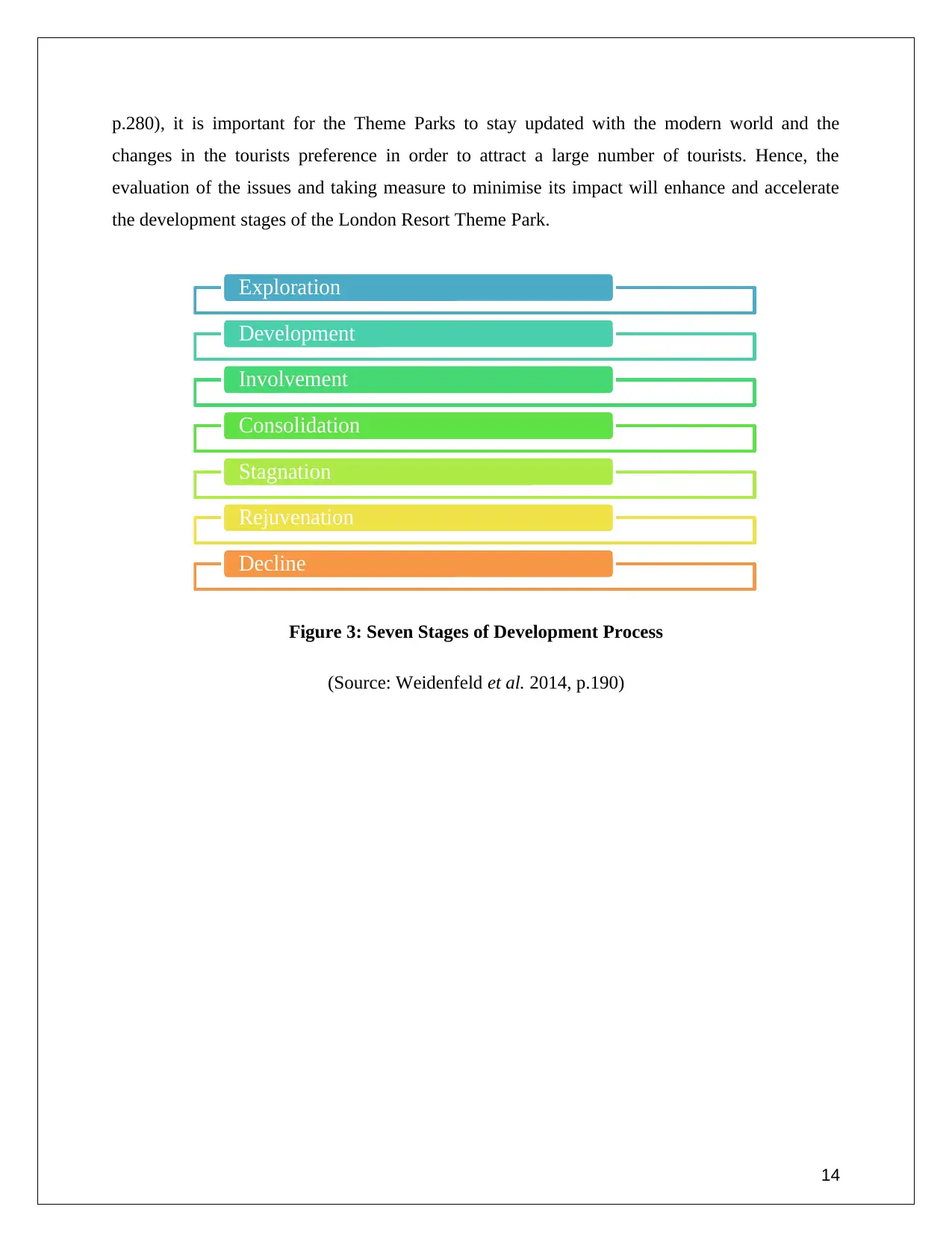
p.280), it is important for the Theme Parks to stay updated with the modern world and the
changes in the tourists preference in order to attract a large number of tourists. Hence, the
evaluation of the issues and taking measure to minimise its impact will enhance and accelerate
the development stages of the London Resort Theme Park.
Figure 3: Seven Stages of Development Process
(Source: Weidenfeld et al. 2014, p.190)
14
Exploration
Development
Involvement
Consolidation
Stagnation
Rejuvenation
Decline
changes in the tourists preference in order to attract a large number of tourists. Hence, the
evaluation of the issues and taking measure to minimise its impact will enhance and accelerate
the development stages of the London Resort Theme Park.
Figure 3: Seven Stages of Development Process
(Source: Weidenfeld et al. 2014, p.190)
14
Exploration
Development
Involvement
Consolidation
Stagnation
Rejuvenation
Decline
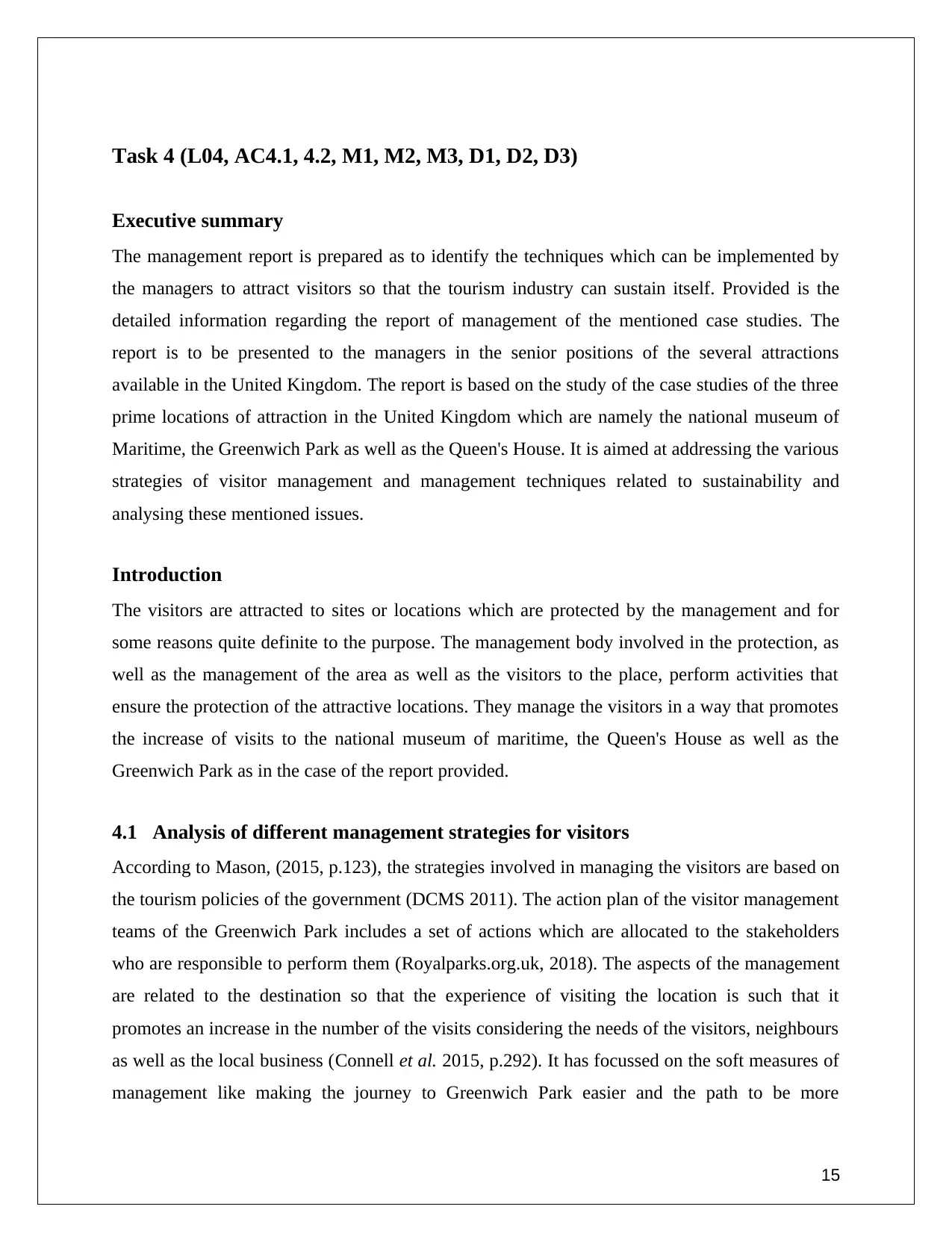
Task 4 (L04, AC4.1, 4.2, M1, M2, M3, D1, D2, D3)
Executive summary
The management report is prepared as to identify the techniques which can be implemented by
the managers to attract visitors so that the tourism industry can sustain itself. Provided is the
detailed information regarding the report of management of the mentioned case studies. The
report is to be presented to the managers in the senior positions of the several attractions
available in the United Kingdom. The report is based on the study of the case studies of the three
prime locations of attraction in the United Kingdom which are namely the national museum of
Maritime, the Greenwich Park as well as the Queen's House. It is aimed at addressing the various
strategies of visitor management and management techniques related to sustainability and
analysing these mentioned issues.
Introduction
The visitors are attracted to sites or locations which are protected by the management and for
some reasons quite definite to the purpose. The management body involved in the protection, as
well as the management of the area as well as the visitors to the place, perform activities that
ensure the protection of the attractive locations. They manage the visitors in a way that promotes
the increase of visits to the national museum of maritime, the Queen's House as well as the
Greenwich Park as in the case of the report provided.
4.1 Analysis of different management strategies for visitors
According to Mason, (2015, p.123), the strategies involved in managing the visitors are based on
the tourism policies of the government (DCMS 2011). The action plan of the visitor management
teams of the Greenwich Park includes a set of actions which are allocated to the stakeholders
who are responsible to perform them (Royalparks.org.uk, 2018). The aspects of the management
are related to the destination so that the experience of visiting the location is such that it
promotes an increase in the number of the visits considering the needs of the visitors, neighbours
as well as the local business (Connell et al. 2015, p.292). It has focussed on the soft measures of
management like making the journey to Greenwich Park easier and the path to be more
15
Executive summary
The management report is prepared as to identify the techniques which can be implemented by
the managers to attract visitors so that the tourism industry can sustain itself. Provided is the
detailed information regarding the report of management of the mentioned case studies. The
report is to be presented to the managers in the senior positions of the several attractions
available in the United Kingdom. The report is based on the study of the case studies of the three
prime locations of attraction in the United Kingdom which are namely the national museum of
Maritime, the Greenwich Park as well as the Queen's House. It is aimed at addressing the various
strategies of visitor management and management techniques related to sustainability and
analysing these mentioned issues.
Introduction
The visitors are attracted to sites or locations which are protected by the management and for
some reasons quite definite to the purpose. The management body involved in the protection, as
well as the management of the area as well as the visitors to the place, perform activities that
ensure the protection of the attractive locations. They manage the visitors in a way that promotes
the increase of visits to the national museum of maritime, the Queen's House as well as the
Greenwich Park as in the case of the report provided.
4.1 Analysis of different management strategies for visitors
According to Mason, (2015, p.123), the strategies involved in managing the visitors are based on
the tourism policies of the government (DCMS 2011). The action plan of the visitor management
teams of the Greenwich Park includes a set of actions which are allocated to the stakeholders
who are responsible to perform them (Royalparks.org.uk, 2018). The aspects of the management
are related to the destination so that the experience of visiting the location is such that it
promotes an increase in the number of the visits considering the needs of the visitors, neighbours
as well as the local business (Connell et al. 2015, p.292). It has focussed on the soft measures of
management like making the journey to Greenwich Park easier and the path to be more
15

accessible, provide signage at locations to make the visit around more lively and give a vibrant
and strong feeling of the place. It has been successful in persuading local hoteliers to provide
accommodations for overnight stays for the visitors coming from faraway places. The strategies
of the Queen's House are more focussed on the hard measures which are concentrated on the
restrictions of the visitors and their activities on the place. The hard measures are not literally
hard but are more concentrated on involving the local community in the park. These measures
are enforced as to protect the biodiversity of the park relative to the flora and the fauna. The soft
measures of the House involve the design of events and marketing strategies that can induce the
coordination of the visitors.
Figure 4: Management strategies
(Source: Weidenfeld et al. 2014, p.190)
As per the strategy implemented several of the events, as well as occasions, are held to promote
the Queen's House. The related information is made available on the official website of the
Community Council of Glasgow. The events are held throughout the year and the summer
months include events which are more action-oriented like sports, cultural and local events.
These involve the participation in the performances by the local community to which the
16
marketing strategie
biodiversity
park
vibrant and
strong
feeling
and strong feeling of the place. It has been successful in persuading local hoteliers to provide
accommodations for overnight stays for the visitors coming from faraway places. The strategies
of the Queen's House are more focussed on the hard measures which are concentrated on the
restrictions of the visitors and their activities on the place. The hard measures are not literally
hard but are more concentrated on involving the local community in the park. These measures
are enforced as to protect the biodiversity of the park relative to the flora and the fauna. The soft
measures of the House involve the design of events and marketing strategies that can induce the
coordination of the visitors.
Figure 4: Management strategies
(Source: Weidenfeld et al. 2014, p.190)
As per the strategy implemented several of the events, as well as occasions, are held to promote
the Queen's House. The related information is made available on the official website of the
Community Council of Glasgow. The events are held throughout the year and the summer
months include events which are more action-oriented like sports, cultural and local events.
These involve the participation in the performances by the local community to which the
16
marketing strategie
biodiversity
park
vibrant and
strong
feeling
Secure Best Marks with AI Grader
Need help grading? Try our AI Grader for instant feedback on your assignments.
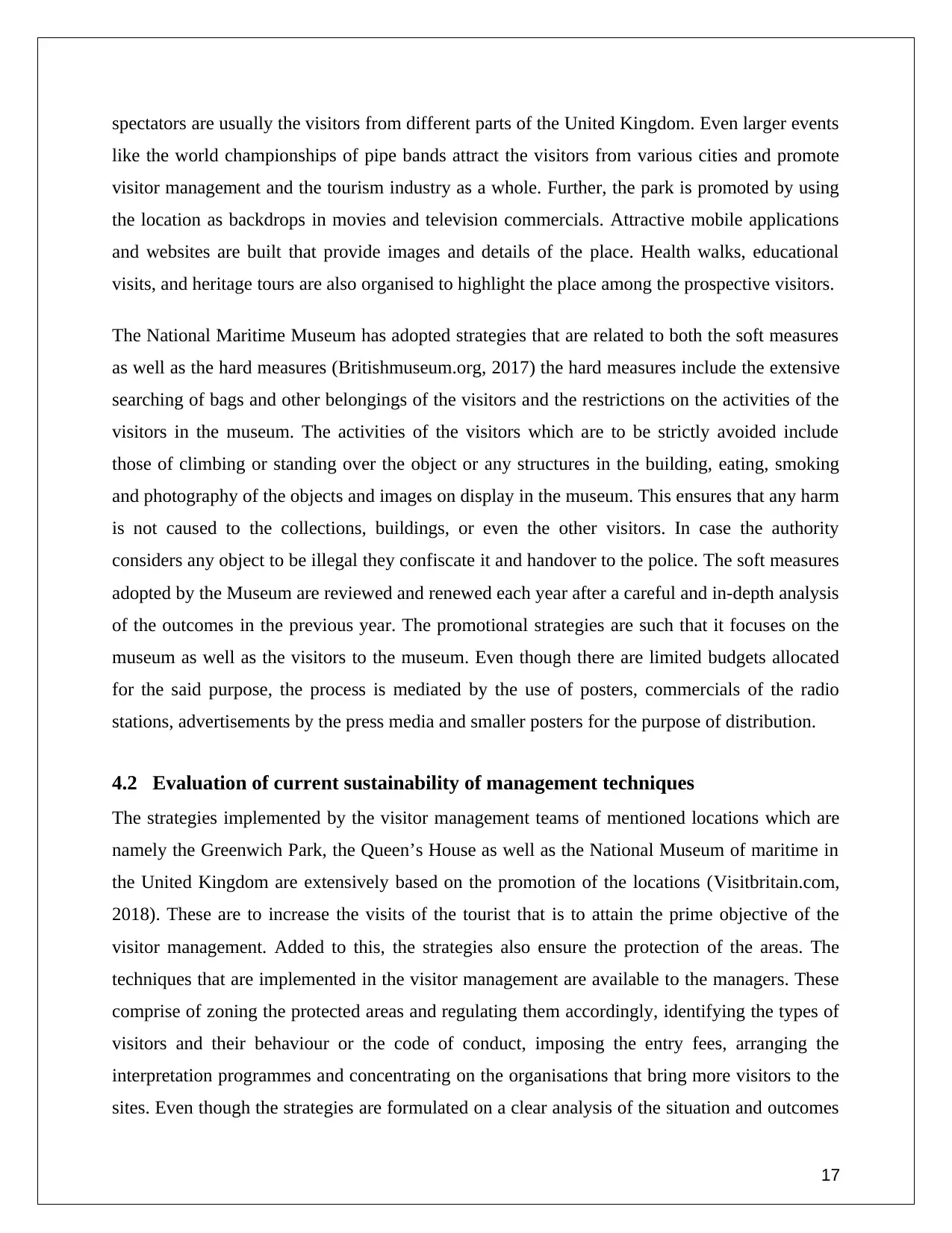
spectators are usually the visitors from different parts of the United Kingdom. Even larger events
like the world championships of pipe bands attract the visitors from various cities and promote
visitor management and the tourism industry as a whole. Further, the park is promoted by using
the location as backdrops in movies and television commercials. Attractive mobile applications
and websites are built that provide images and details of the place. Health walks, educational
visits, and heritage tours are also organised to highlight the place among the prospective visitors.
The National Maritime Museum has adopted strategies that are related to both the soft measures
as well as the hard measures (Britishmuseum.org, 2017) the hard measures include the extensive
searching of bags and other belongings of the visitors and the restrictions on the activities of the
visitors in the museum. The activities of the visitors which are to be strictly avoided include
those of climbing or standing over the object or any structures in the building, eating, smoking
and photography of the objects and images on display in the museum. This ensures that any harm
is not caused to the collections, buildings, or even the other visitors. In case the authority
considers any object to be illegal they confiscate it and handover to the police. The soft measures
adopted by the Museum are reviewed and renewed each year after a careful and in-depth analysis
of the outcomes in the previous year. The promotional strategies are such that it focuses on the
museum as well as the visitors to the museum. Even though there are limited budgets allocated
for the said purpose, the process is mediated by the use of posters, commercials of the radio
stations, advertisements by the press media and smaller posters for the purpose of distribution.
4.2 Evaluation of current sustainability of management techniques
The strategies implemented by the visitor management teams of mentioned locations which are
namely the Greenwich Park, the Queen’s House as well as the National Museum of maritime in
the United Kingdom are extensively based on the promotion of the locations (Visitbritain.com,
2018). These are to increase the visits of the tourist that is to attain the prime objective of the
visitor management. Added to this, the strategies also ensure the protection of the areas. The
techniques that are implemented in the visitor management are available to the managers. These
comprise of zoning the protected areas and regulating them accordingly, identifying the types of
visitors and their behaviour or the code of conduct, imposing the entry fees, arranging the
interpretation programmes and concentrating on the organisations that bring more visitors to the
sites. Even though the strategies are formulated on a clear analysis of the situation and outcomes
17
like the world championships of pipe bands attract the visitors from various cities and promote
visitor management and the tourism industry as a whole. Further, the park is promoted by using
the location as backdrops in movies and television commercials. Attractive mobile applications
and websites are built that provide images and details of the place. Health walks, educational
visits, and heritage tours are also organised to highlight the place among the prospective visitors.
The National Maritime Museum has adopted strategies that are related to both the soft measures
as well as the hard measures (Britishmuseum.org, 2017) the hard measures include the extensive
searching of bags and other belongings of the visitors and the restrictions on the activities of the
visitors in the museum. The activities of the visitors which are to be strictly avoided include
those of climbing or standing over the object or any structures in the building, eating, smoking
and photography of the objects and images on display in the museum. This ensures that any harm
is not caused to the collections, buildings, or even the other visitors. In case the authority
considers any object to be illegal they confiscate it and handover to the police. The soft measures
adopted by the Museum are reviewed and renewed each year after a careful and in-depth analysis
of the outcomes in the previous year. The promotional strategies are such that it focuses on the
museum as well as the visitors to the museum. Even though there are limited budgets allocated
for the said purpose, the process is mediated by the use of posters, commercials of the radio
stations, advertisements by the press media and smaller posters for the purpose of distribution.
4.2 Evaluation of current sustainability of management techniques
The strategies implemented by the visitor management teams of mentioned locations which are
namely the Greenwich Park, the Queen’s House as well as the National Museum of maritime in
the United Kingdom are extensively based on the promotion of the locations (Visitbritain.com,
2018). These are to increase the visits of the tourist that is to attain the prime objective of the
visitor management. Added to this, the strategies also ensure the protection of the areas. The
techniques that are implemented in the visitor management are available to the managers. These
comprise of zoning the protected areas and regulating them accordingly, identifying the types of
visitors and their behaviour or the code of conduct, imposing the entry fees, arranging the
interpretation programmes and concentrating on the organisations that bring more visitors to the
sites. Even though the strategies are formulated on a clear analysis of the situation and outcomes
17
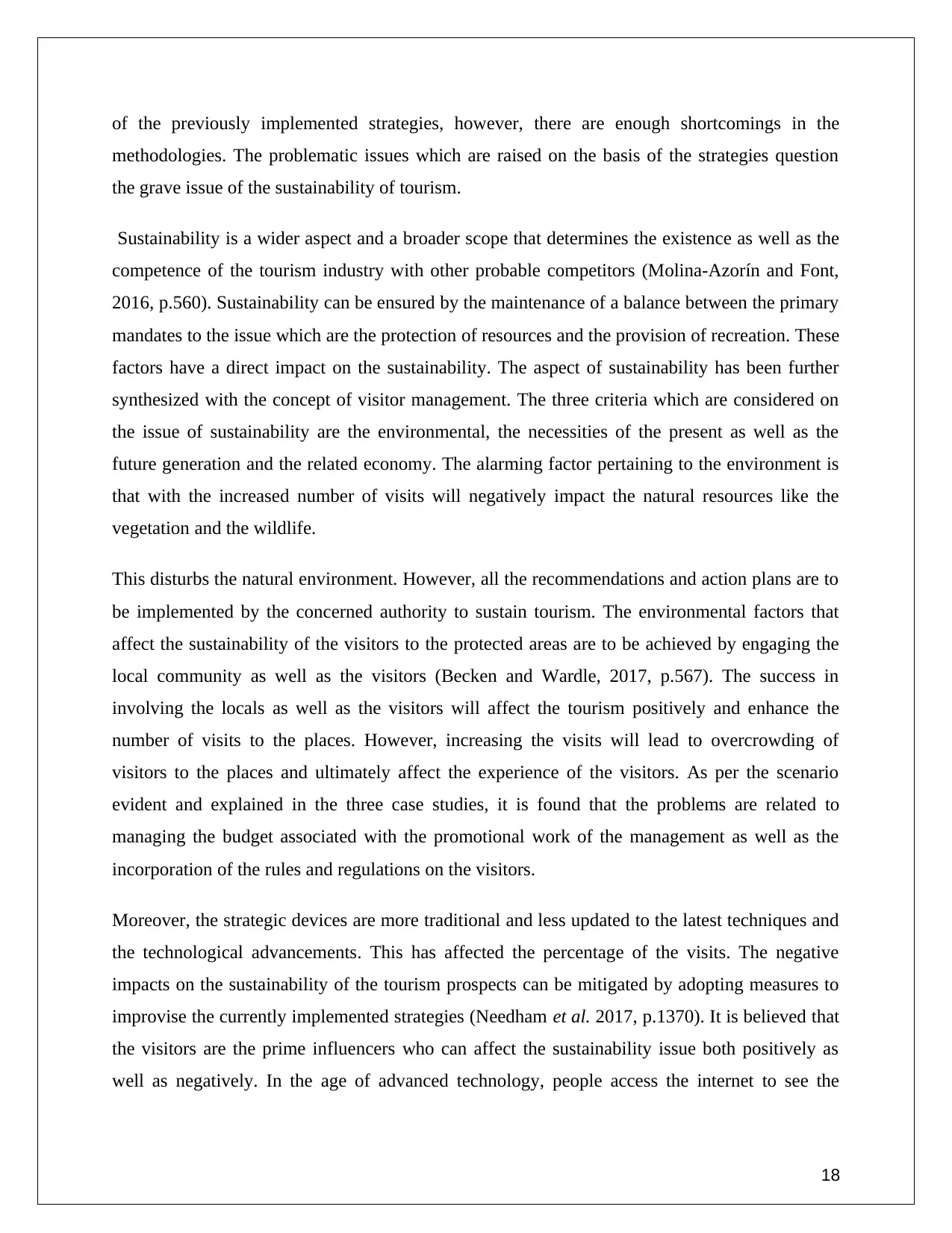
of the previously implemented strategies, however, there are enough shortcomings in the
methodologies. The problematic issues which are raised on the basis of the strategies question
the grave issue of the sustainability of tourism.
Sustainability is a wider aspect and a broader scope that determines the existence as well as the
competence of the tourism industry with other probable competitors (Molina-Azorín and Font,
2016, p.560). Sustainability can be ensured by the maintenance of a balance between the primary
mandates to the issue which are the protection of resources and the provision of recreation. These
factors have a direct impact on the sustainability. The aspect of sustainability has been further
synthesized with the concept of visitor management. The three criteria which are considered on
the issue of sustainability are the environmental, the necessities of the present as well as the
future generation and the related economy. The alarming factor pertaining to the environment is
that with the increased number of visits will negatively impact the natural resources like the
vegetation and the wildlife.
This disturbs the natural environment. However, all the recommendations and action plans are to
be implemented by the concerned authority to sustain tourism. The environmental factors that
affect the sustainability of the visitors to the protected areas are to be achieved by engaging the
local community as well as the visitors (Becken and Wardle, 2017, p.567). The success in
involving the locals as well as the visitors will affect the tourism positively and enhance the
number of visits to the places. However, increasing the visits will lead to overcrowding of
visitors to the places and ultimately affect the experience of the visitors. As per the scenario
evident and explained in the three case studies, it is found that the problems are related to
managing the budget associated with the promotional work of the management as well as the
incorporation of the rules and regulations on the visitors.
Moreover, the strategic devices are more traditional and less updated to the latest techniques and
the technological advancements. This has affected the percentage of the visits. The negative
impacts on the sustainability of the tourism prospects can be mitigated by adopting measures to
improvise the currently implemented strategies (Needham et al. 2017, p.1370). It is believed that
the visitors are the prime influencers who can affect the sustainability issue both positively as
well as negatively. In the age of advanced technology, people access the internet to see the
18
methodologies. The problematic issues which are raised on the basis of the strategies question
the grave issue of the sustainability of tourism.
Sustainability is a wider aspect and a broader scope that determines the existence as well as the
competence of the tourism industry with other probable competitors (Molina-Azorín and Font,
2016, p.560). Sustainability can be ensured by the maintenance of a balance between the primary
mandates to the issue which are the protection of resources and the provision of recreation. These
factors have a direct impact on the sustainability. The aspect of sustainability has been further
synthesized with the concept of visitor management. The three criteria which are considered on
the issue of sustainability are the environmental, the necessities of the present as well as the
future generation and the related economy. The alarming factor pertaining to the environment is
that with the increased number of visits will negatively impact the natural resources like the
vegetation and the wildlife.
This disturbs the natural environment. However, all the recommendations and action plans are to
be implemented by the concerned authority to sustain tourism. The environmental factors that
affect the sustainability of the visitors to the protected areas are to be achieved by engaging the
local community as well as the visitors (Becken and Wardle, 2017, p.567). The success in
involving the locals as well as the visitors will affect the tourism positively and enhance the
number of visits to the places. However, increasing the visits will lead to overcrowding of
visitors to the places and ultimately affect the experience of the visitors. As per the scenario
evident and explained in the three case studies, it is found that the problems are related to
managing the budget associated with the promotional work of the management as well as the
incorporation of the rules and regulations on the visitors.
Moreover, the strategic devices are more traditional and less updated to the latest techniques and
the technological advancements. This has affected the percentage of the visits. The negative
impacts on the sustainability of the tourism prospects can be mitigated by adopting measures to
improvise the currently implemented strategies (Needham et al. 2017, p.1370). It is believed that
the visitors are the prime influencers who can affect the sustainability issue both positively as
well as negatively. In the age of advanced technology, people access the internet to see the
18
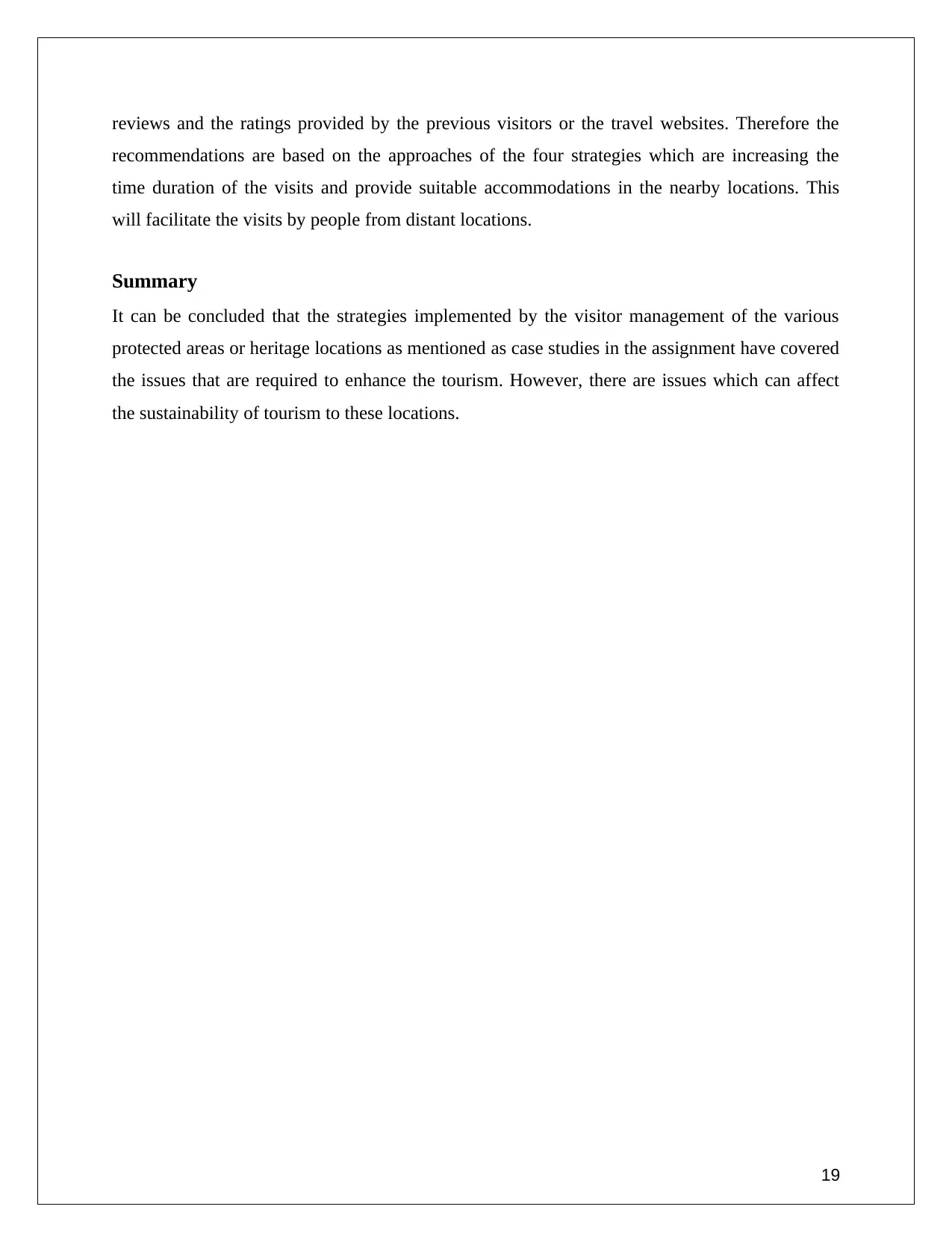
reviews and the ratings provided by the previous visitors or the travel websites. Therefore the
recommendations are based on the approaches of the four strategies which are increasing the
time duration of the visits and provide suitable accommodations in the nearby locations. This
will facilitate the visits by people from distant locations.
Summary
It can be concluded that the strategies implemented by the visitor management of the various
protected areas or heritage locations as mentioned as case studies in the assignment have covered
the issues that are required to enhance the tourism. However, there are issues which can affect
the sustainability of tourism to these locations.
19
recommendations are based on the approaches of the four strategies which are increasing the
time duration of the visits and provide suitable accommodations in the nearby locations. This
will facilitate the visits by people from distant locations.
Summary
It can be concluded that the strategies implemented by the visitor management of the various
protected areas or heritage locations as mentioned as case studies in the assignment have covered
the issues that are required to enhance the tourism. However, there are issues which can affect
the sustainability of tourism to these locations.
19
Paraphrase This Document
Need a fresh take? Get an instant paraphrase of this document with our AI Paraphraser
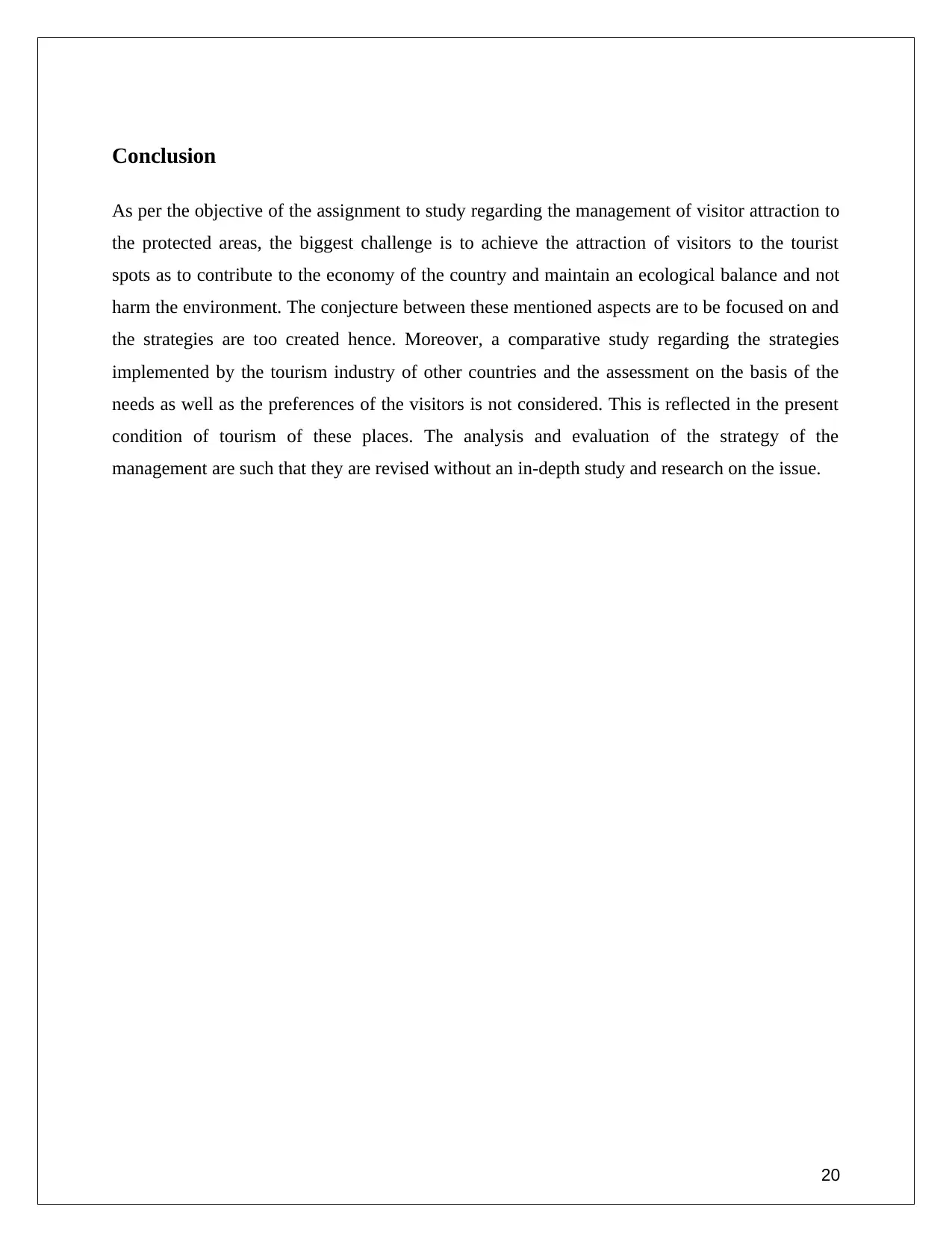
Conclusion
As per the objective of the assignment to study regarding the management of visitor attraction to
the protected areas, the biggest challenge is to achieve the attraction of visitors to the tourist
spots as to contribute to the economy of the country and maintain an ecological balance and not
harm the environment. The conjecture between these mentioned aspects are to be focused on and
the strategies are too created hence. Moreover, a comparative study regarding the strategies
implemented by the tourism industry of other countries and the assessment on the basis of the
needs as well as the preferences of the visitors is not considered. This is reflected in the present
condition of tourism of these places. The analysis and evaluation of the strategy of the
management are such that they are revised without an in-depth study and research on the issue.
20
As per the objective of the assignment to study regarding the management of visitor attraction to
the protected areas, the biggest challenge is to achieve the attraction of visitors to the tourist
spots as to contribute to the economy of the country and maintain an ecological balance and not
harm the environment. The conjecture between these mentioned aspects are to be focused on and
the strategies are too created hence. Moreover, a comparative study regarding the strategies
implemented by the tourism industry of other countries and the assessment on the basis of the
needs as well as the preferences of the visitors is not considered. This is reflected in the present
condition of tourism of these places. The analysis and evaluation of the strategy of the
management are such that they are revised without an in-depth study and research on the issue.
20
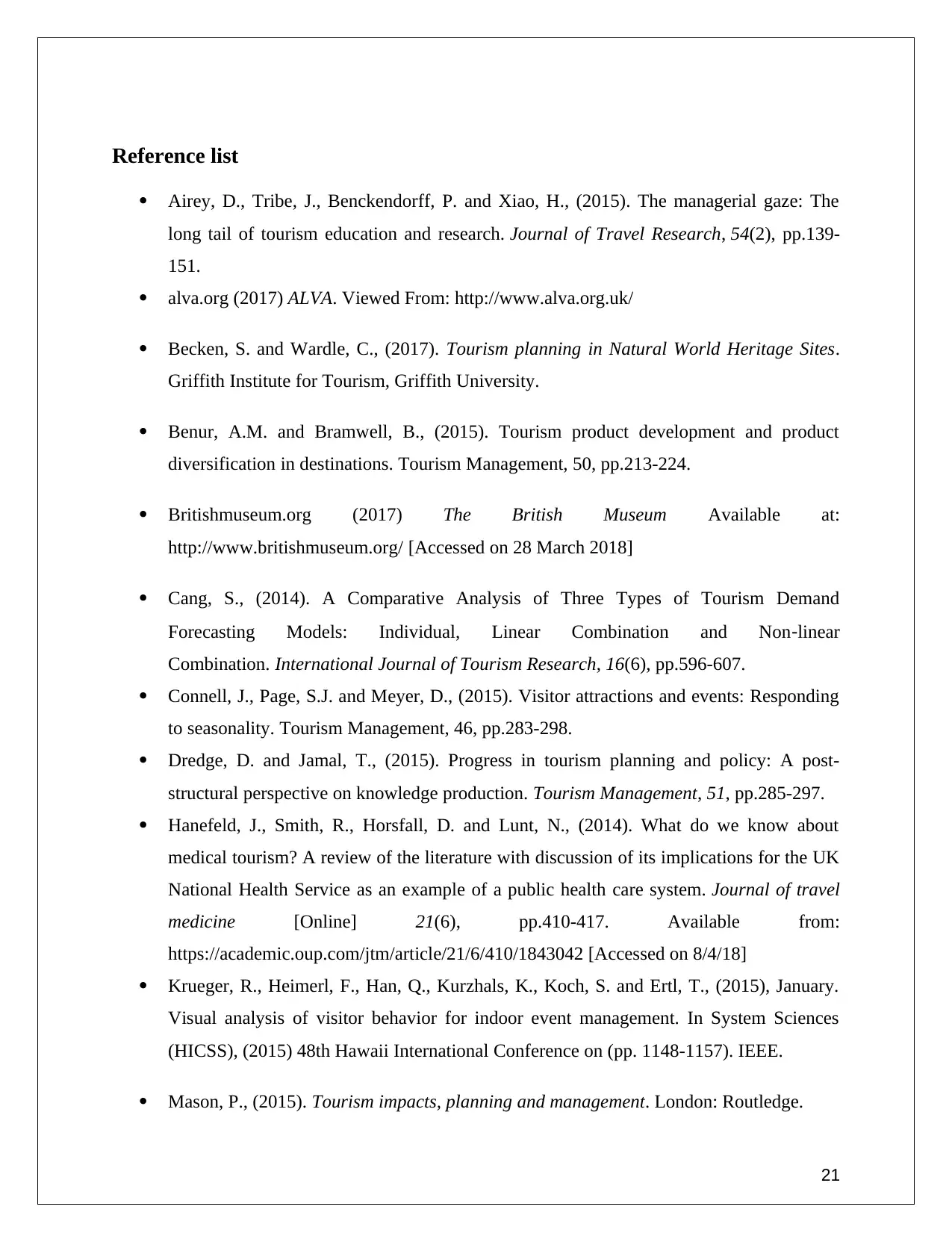
Reference list
Airey, D., Tribe, J., Benckendorff, P. and Xiao, H., (2015). The managerial gaze: The
long tail of tourism education and research. Journal of Travel Research, 54(2), pp.139-
151.
alva.org (2017) ALVA. Viewed From: http://www.alva.org.uk/
Becken, S. and Wardle, C., (2017). Tourism planning in Natural World Heritage Sites.
Griffith Institute for Tourism, Griffith University.
Benur, A.M. and Bramwell, B., (2015). Tourism product development and product
diversification in destinations. Tourism Management, 50, pp.213-224.
Britishmuseum.org (2017) The British Museum Available at:
http://www.britishmuseum.org/ [Accessed on 28 March 2018]
Cang, S., (2014). A Comparative Analysis of Three Types of Tourism Demand
Forecasting Models: Individual, Linear Combination and Non‐linear
Combination. International Journal of Tourism Research, 16(6), pp.596-607.
Connell, J., Page, S.J. and Meyer, D., (2015). Visitor attractions and events: Responding
to seasonality. Tourism Management, 46, pp.283-298.
Dredge, D. and Jamal, T., (2015). Progress in tourism planning and policy: A post-
structural perspective on knowledge production. Tourism Management, 51, pp.285-297.
Hanefeld, J., Smith, R., Horsfall, D. and Lunt, N., (2014). What do we know about
medical tourism? A review of the literature with discussion of its implications for the UK
National Health Service as an example of a public health care system. Journal of travel
medicine [Online] 21(6), pp.410-417. Available from:
https://academic.oup.com/jtm/article/21/6/410/1843042 [Accessed on 8/4/18]
Krueger, R., Heimerl, F., Han, Q., Kurzhals, K., Koch, S. and Ertl, T., (2015), January.
Visual analysis of visitor behavior for indoor event management. In System Sciences
(HICSS), (2015) 48th Hawaii International Conference on (pp. 1148-1157). IEEE.
Mason, P., (2015). Tourism impacts, planning and management. London: Routledge.
21
Airey, D., Tribe, J., Benckendorff, P. and Xiao, H., (2015). The managerial gaze: The
long tail of tourism education and research. Journal of Travel Research, 54(2), pp.139-
151.
alva.org (2017) ALVA. Viewed From: http://www.alva.org.uk/
Becken, S. and Wardle, C., (2017). Tourism planning in Natural World Heritage Sites.
Griffith Institute for Tourism, Griffith University.
Benur, A.M. and Bramwell, B., (2015). Tourism product development and product
diversification in destinations. Tourism Management, 50, pp.213-224.
Britishmuseum.org (2017) The British Museum Available at:
http://www.britishmuseum.org/ [Accessed on 28 March 2018]
Cang, S., (2014). A Comparative Analysis of Three Types of Tourism Demand
Forecasting Models: Individual, Linear Combination and Non‐linear
Combination. International Journal of Tourism Research, 16(6), pp.596-607.
Connell, J., Page, S.J. and Meyer, D., (2015). Visitor attractions and events: Responding
to seasonality. Tourism Management, 46, pp.283-298.
Dredge, D. and Jamal, T., (2015). Progress in tourism planning and policy: A post-
structural perspective on knowledge production. Tourism Management, 51, pp.285-297.
Hanefeld, J., Smith, R., Horsfall, D. and Lunt, N., (2014). What do we know about
medical tourism? A review of the literature with discussion of its implications for the UK
National Health Service as an example of a public health care system. Journal of travel
medicine [Online] 21(6), pp.410-417. Available from:
https://academic.oup.com/jtm/article/21/6/410/1843042 [Accessed on 8/4/18]
Krueger, R., Heimerl, F., Han, Q., Kurzhals, K., Koch, S. and Ertl, T., (2015), January.
Visual analysis of visitor behavior for indoor event management. In System Sciences
(HICSS), (2015) 48th Hawaii International Conference on (pp. 1148-1157). IEEE.
Mason, P., (2015). Tourism impacts, planning and management. London: Routledge.
21
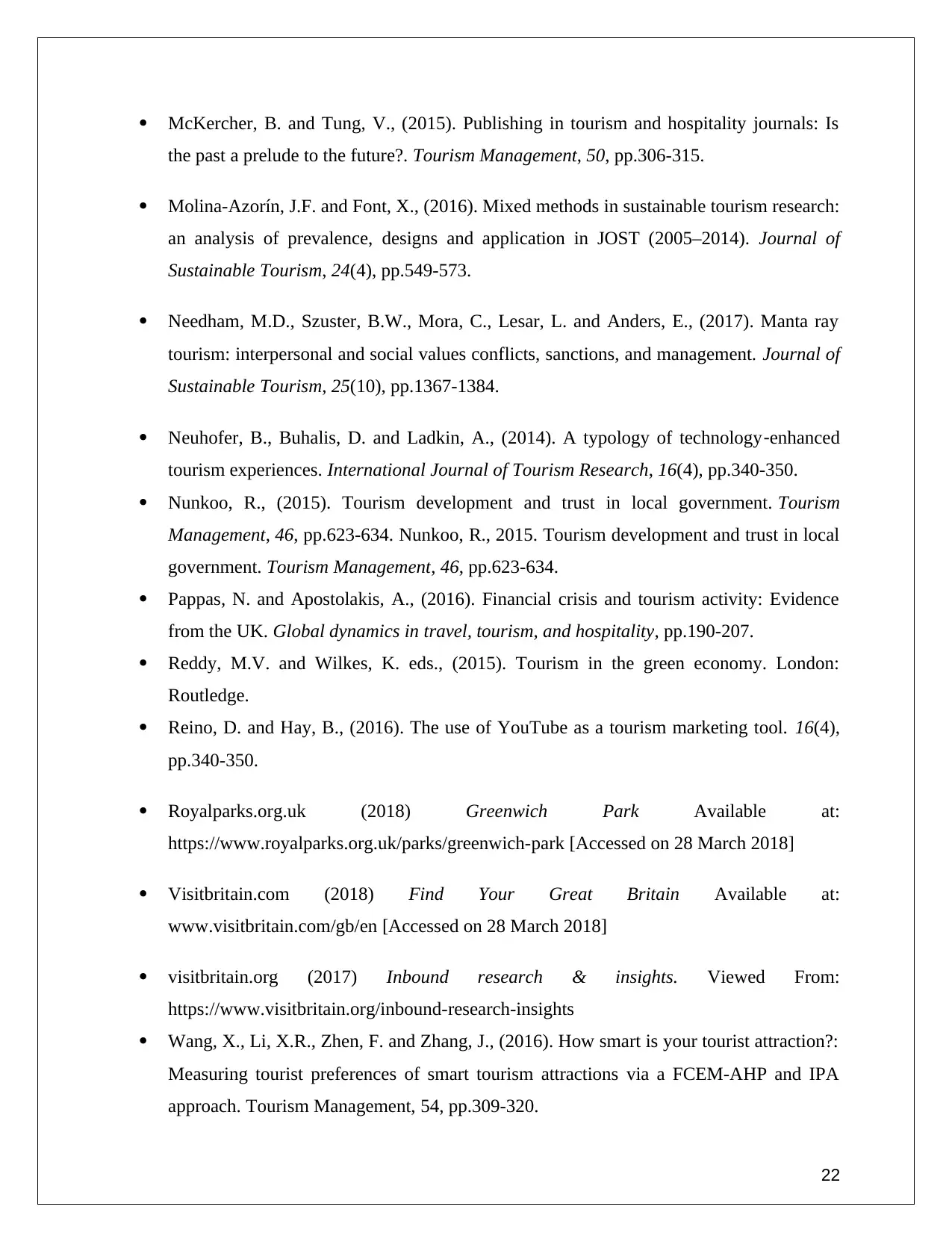
McKercher, B. and Tung, V., (2015). Publishing in tourism and hospitality journals: Is
the past a prelude to the future?. Tourism Management, 50, pp.306-315.
Molina-Azorín, J.F. and Font, X., (2016). Mixed methods in sustainable tourism research:
an analysis of prevalence, designs and application in JOST (2005–2014). Journal of
Sustainable Tourism, 24(4), pp.549-573.
Needham, M.D., Szuster, B.W., Mora, C., Lesar, L. and Anders, E., (2017). Manta ray
tourism: interpersonal and social values conflicts, sanctions, and management. Journal of
Sustainable Tourism, 25(10), pp.1367-1384.
Neuhofer, B., Buhalis, D. and Ladkin, A., (2014). A typology of technology‐enhanced
tourism experiences. International Journal of Tourism Research, 16(4), pp.340-350.
Nunkoo, R., (2015). Tourism development and trust in local government. Tourism
Management, 46, pp.623-634. Nunkoo, R., 2015. Tourism development and trust in local
government. Tourism Management, 46, pp.623-634.
Pappas, N. and Apostolakis, A., (2016). Financial crisis and tourism activity: Evidence
from the UK. Global dynamics in travel, tourism, and hospitality, pp.190-207.
Reddy, M.V. and Wilkes, K. eds., (2015). Tourism in the green economy. London:
Routledge.
Reino, D. and Hay, B., (2016). The use of YouTube as a tourism marketing tool. 16(4),
pp.340-350.
Royalparks.org.uk (2018) Greenwich Park Available at:
https://www.royalparks.org.uk/parks/greenwich-park [Accessed on 28 March 2018]
Visitbritain.com (2018) Find Your Great Britain Available at:
www.visitbritain.com/gb/en [Accessed on 28 March 2018]
visitbritain.org (2017) Inbound research & insights. Viewed From:
https://www.visitbritain.org/inbound-research-insights
Wang, X., Li, X.R., Zhen, F. and Zhang, J., (2016). How smart is your tourist attraction?:
Measuring tourist preferences of smart tourism attractions via a FCEM-AHP and IPA
approach. Tourism Management, 54, pp.309-320.
22
the past a prelude to the future?. Tourism Management, 50, pp.306-315.
Molina-Azorín, J.F. and Font, X., (2016). Mixed methods in sustainable tourism research:
an analysis of prevalence, designs and application in JOST (2005–2014). Journal of
Sustainable Tourism, 24(4), pp.549-573.
Needham, M.D., Szuster, B.W., Mora, C., Lesar, L. and Anders, E., (2017). Manta ray
tourism: interpersonal and social values conflicts, sanctions, and management. Journal of
Sustainable Tourism, 25(10), pp.1367-1384.
Neuhofer, B., Buhalis, D. and Ladkin, A., (2014). A typology of technology‐enhanced
tourism experiences. International Journal of Tourism Research, 16(4), pp.340-350.
Nunkoo, R., (2015). Tourism development and trust in local government. Tourism
Management, 46, pp.623-634. Nunkoo, R., 2015. Tourism development and trust in local
government. Tourism Management, 46, pp.623-634.
Pappas, N. and Apostolakis, A., (2016). Financial crisis and tourism activity: Evidence
from the UK. Global dynamics in travel, tourism, and hospitality, pp.190-207.
Reddy, M.V. and Wilkes, K. eds., (2015). Tourism in the green economy. London:
Routledge.
Reino, D. and Hay, B., (2016). The use of YouTube as a tourism marketing tool. 16(4),
pp.340-350.
Royalparks.org.uk (2018) Greenwich Park Available at:
https://www.royalparks.org.uk/parks/greenwich-park [Accessed on 28 March 2018]
Visitbritain.com (2018) Find Your Great Britain Available at:
www.visitbritain.com/gb/en [Accessed on 28 March 2018]
visitbritain.org (2017) Inbound research & insights. Viewed From:
https://www.visitbritain.org/inbound-research-insights
Wang, X., Li, X.R., Zhen, F. and Zhang, J., (2016). How smart is your tourist attraction?:
Measuring tourist preferences of smart tourism attractions via a FCEM-AHP and IPA
approach. Tourism Management, 54, pp.309-320.
22
Secure Best Marks with AI Grader
Need help grading? Try our AI Grader for instant feedback on your assignments.
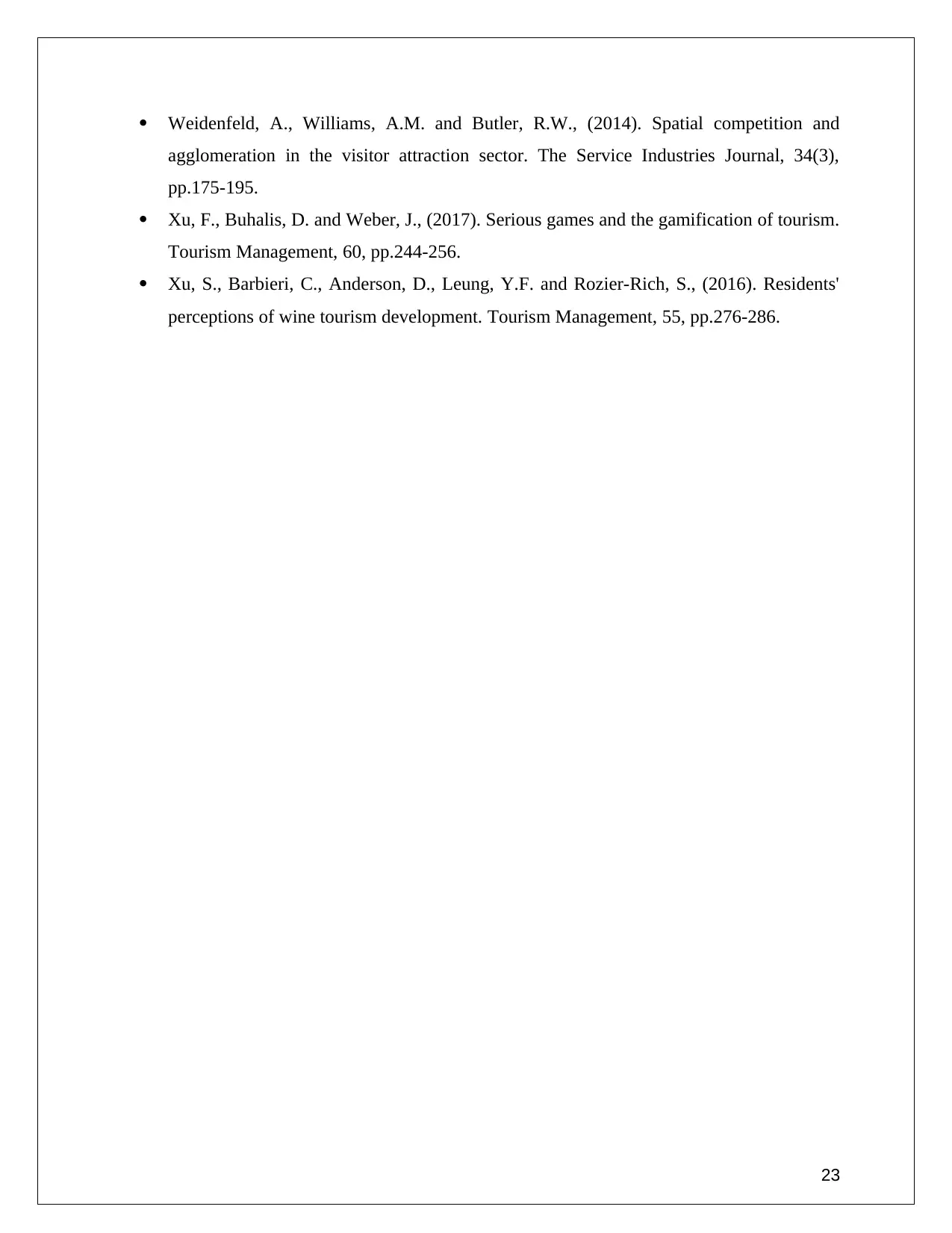
Weidenfeld, A., Williams, A.M. and Butler, R.W., (2014). Spatial competition and
agglomeration in the visitor attraction sector. The Service Industries Journal, 34(3),
pp.175-195.
Xu, F., Buhalis, D. and Weber, J., (2017). Serious games and the gamification of tourism.
Tourism Management, 60, pp.244-256.
Xu, S., Barbieri, C., Anderson, D., Leung, Y.F. and Rozier-Rich, S., (2016). Residents'
perceptions of wine tourism development. Tourism Management, 55, pp.276-286.
23
agglomeration in the visitor attraction sector. The Service Industries Journal, 34(3),
pp.175-195.
Xu, F., Buhalis, D. and Weber, J., (2017). Serious games and the gamification of tourism.
Tourism Management, 60, pp.244-256.
Xu, S., Barbieri, C., Anderson, D., Leung, Y.F. and Rozier-Rich, S., (2016). Residents'
perceptions of wine tourism development. Tourism Management, 55, pp.276-286.
23
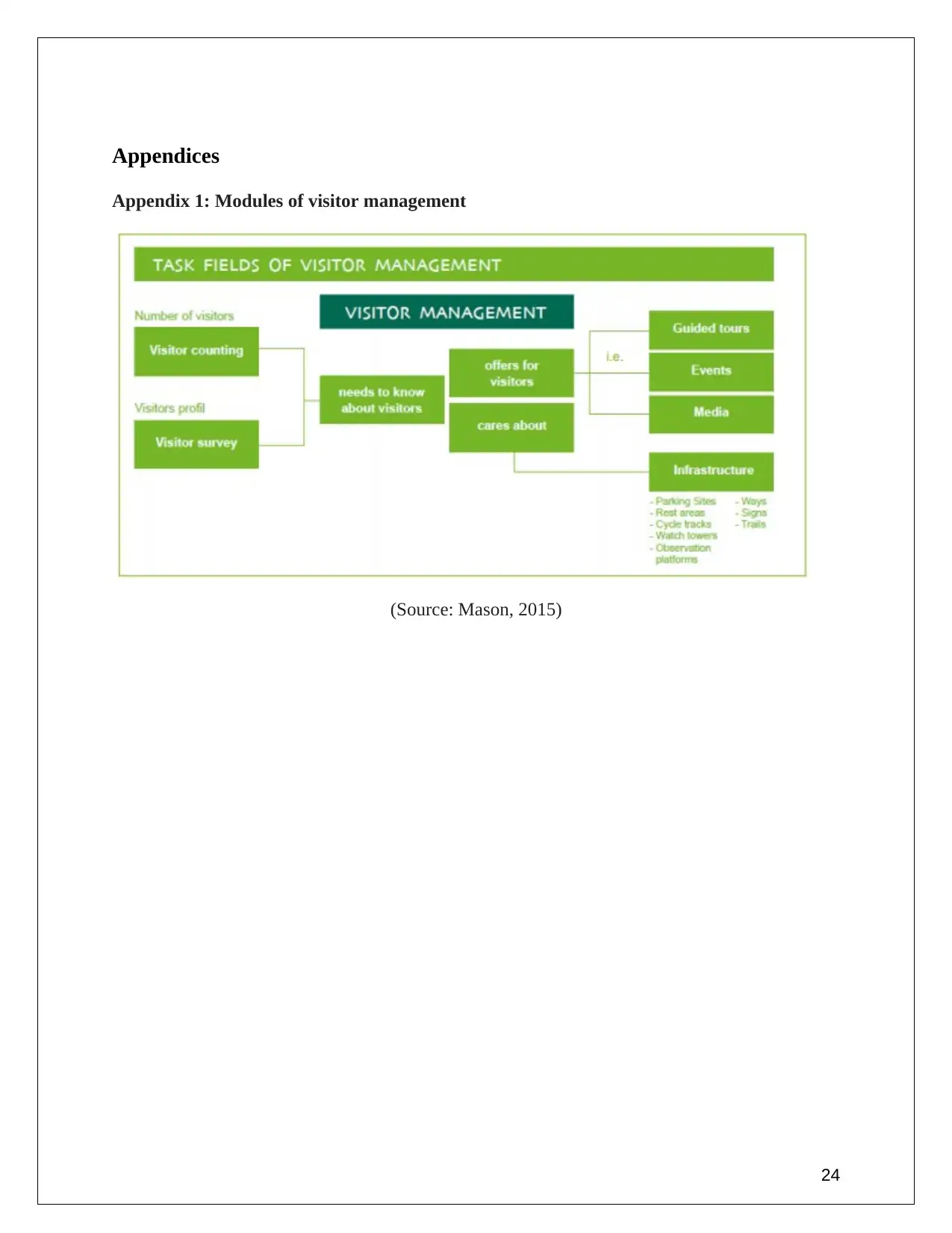
Appendices
Appendix 1: Modules of visitor management
(Source: Mason, 2015)
24
Appendix 1: Modules of visitor management
(Source: Mason, 2015)
24

Appendix 2: Visitor management strategies of UK
(Source: Visitbritain.com, 2018)
25
(Source: Visitbritain.com, 2018)
25
Paraphrase This Document
Need a fresh take? Get an instant paraphrase of this document with our AI Paraphraser
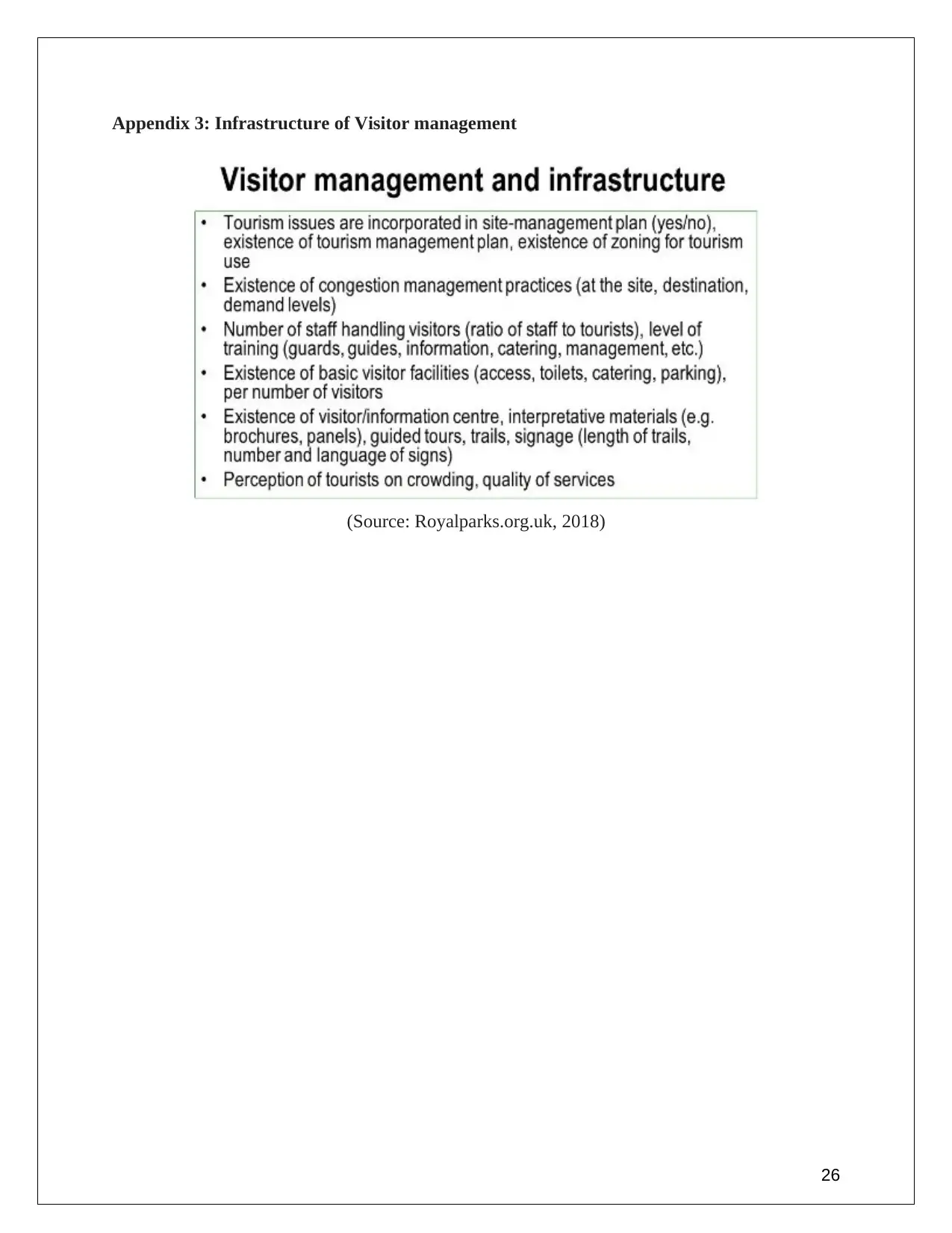
Appendix 3: Infrastructure of Visitor management
(Source: Royalparks.org.uk, 2018)
26
(Source: Royalparks.org.uk, 2018)
26
1 out of 26
Related Documents
Your All-in-One AI-Powered Toolkit for Academic Success.
+13062052269
info@desklib.com
Available 24*7 on WhatsApp / Email
![[object Object]](/_next/static/media/star-bottom.7253800d.svg)
Unlock your academic potential
© 2024 | Zucol Services PVT LTD | All rights reserved.





